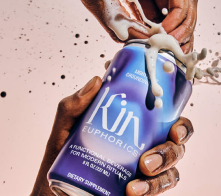Between rising inflation and worries about recession in 2023, you might wonder how to recession-proof your e-commerce business. One of the best things you can do right now is to gain a better understanding of consumer behaviors.
Consumers are most likely to stick with brands they trust when the economy turns. And you build trust with a deep understanding of their pain points and perspectives.
In other words, customer retention can help recession-proof your business. Read on to find out how to implement a solid retention marketing program.

Retention Marketing Starts by Understanding Consumer Behavior
A well-planned customer retention program begins with data. From acquisition to retention, it's essential to connect customer data touch points, including:
- Website Activity
- Social Media Platforms
- Customer Relation Management
- Cart Abandonment
Retention.com provides one-click integrations with over 50 of the world's leading marketing automation platforms, such as:
- Stripe
- Drip
- Marketo
- Salesforce
Why is connecting the information necessary? Using and combining analytics helps you paint a complete picture of consumer behavior.
Additionally, implementing a combination of analytics allows you to understand how new customers find your business, products, and services. You can also determine what keeps them coming back.
It's vital to know what drives consumer behavior in the overall market and specifically for your industry. According to McKinsey and Company research, two-thirds of Americans are worried about inflation.
Additionally, 19% are concerned about climate change and sustainability. How can your business use these two critical pieces of data?
It depends on your specific customer.
Targeted Messaging That's Personal
Not everyone is equally concerned about sustainability or inflation. Research indicates 75% of baby boomers say increasing prices are their top concern.
On the other hand, only 44% of Gen Zers worry about inflation. For this segment, personal and political issues top their list. Ultimately, it's all about perception.
For instance, 30% of respondents on the McKinsey Report believe there's been a significant markup in the prices of skin care products, makeup, baby supplies, toys, and consumer electronics. However, the inflation on these items was only 2% in 2022.
On the other hand, only 25% of respondents believed prices had increased for home and garden supplies. But, in fact, inflation in this category has risen over 11%. The point is that data can help you create targeted messaging that reflects your customers' perceptions.
Targeted messaging works best when you create buyer personas that represent your customers. Then you can generate articles, social posts, emails, and ads that speak directly to their needs and pain points.
Tailor Customer Retention Efforts
You can recession-proof your business by combining buyer personas with a retention strategy. Tailor retention to fit your brand's consumer touch points and business model, and map out post-purchase scenarios.
Some of the key point indicators (KPIs) you should use include:
- Returning Customers
- What they purchase
- How long do they take between purchases
- Customer lifetime value after a year
- How many customers sign up for loyalty programs?
- Revenue generated through email campaigns
These KPIs can help you continually optimize your offers and understand how customer lifetime value grows. Customer retention marketing offers a proven ROI and is vital to recession-proof your e-commerce business.
Develop a retention marketing flow based on the data you've gathered. Personalize these communications from the beginning as soon as your customers make their first purchase.
Follow up by introducing them to your brand philosophies as well as your products. Provide added value with personalized incentives, such as a loyalty program.
Today, brands can stand out among the crowd by offering the most value. Remember to use data to define incentives based on customer pain points and perceptions to increase their lifetime value.
Doing so will help you recession-proof your business and benefit from customer loyalty. To that end, remember to create personas for those who abandon their carts or start shopping elsewhere.
When you have a solid idea of who these consumers are, you can create messaging that speaks directly to them.
Target Cart Abandonment
You can use insights into your customers' reasons for cart abandonment. Not only that, but you can also use identity resolution technology to find out who the consumers are across platforms.
An automated email and SMS customer journey are vital for e-commerce businesses because it helps you help shoppers who abandon their carts.
A series of targeted emails will remind your customers about the items they want to buy. And targeted emails allow you to add an incentive to encourage them to buy.
Otherwise, you're losing out on numerous potential sales. What's more, an effective email automation program enables you to create those personalized experiences customers are looking for these days.
Using customer personas can also help you segment your email list. That way, you can send targeted emails that speak to their pain points and perceptions.
Creating engaging customer experiences reinforces why your customers purchase from your brand. And it keeps them coming back, even in a poor economy.
Retention Marketing and E-Commerce Solutions
Retention.com is a marketing solutions provider specializing in retention marketing and e-commerce solutions. We can help you improve cart abandonment and re-engage potentially lost customers with one-click integrations.
We help businesses reclaim up to ten times more cart abandonment revenue with industry-leading Identity Resolution technology. What that means for you is identifying otherwise unidentified customers.
Then you can create a personalized retention marketing flow that automatically triggers messaging. Help recession-proof your e-commerce business. Contact Retention.com today to set up a demo. We're here to help.
If you own and operate an e-commerce business, customer retention should be at the forefront of your marketing strategy. After all, the buyer's journey doesn't end at acquisition.
Engaging with your customers to build long-term relationships increases customer loyalty. Not only that, but those customers will become more valuable to your business over time.
Customer acquisition versus customer retention is like dating versus marriage. Dating is a chance to get to know people. Once you find that person who fits you perfectly, you want to nurture that relationship.
Similarly, your brand has an ideal customer. When you understand them, you can build a retention marketing strategy to keep them happy.

Building Good Relationships Using Data
The best way to dominate your retention marketing strategy is by thinking long-term. Customer retention means developing extensive insights about your ideal customer.
In other words, understanding how your brand can add value to the buyer's journey is vital. Using a customer relationship management platform (CRM) like Salesforce enables your business to manage customer relationships using data.
Gathering data is essential to developing insights about your customers' demographics, shopping habits, and what they need from your brand. Storing data in one location gives you a complete picture of your customers in real-time, with insights into their patterns.
CRM software organizes all your customer data, customer service notes, and metrics. Additionally, a CRM helps you identify different types of customers and their interests.
That way, you can segment audiences, track customer activity, and work proactively to maintain those meaningful relationships. It's typically easier to upsell and cross-sell to returning customers.
However, remember that the bottom line is to deliver value, not overload them with too much information.
Retention Marketing Strategies to Develop Customer Loyalty
Consider this. Retention starts with your customers' first purchase. You can begin a new relationship with a personalized thank you email, welcoming them to your community.
Then direct them to helpful content, such as product demonstrations or articles responding to their specific needs. Providing educational resources such as e-books, downloadable PDFs, how-to guides, and tutorials reinforces your brand's credibility.
When you know your audience, you can create relative content in various formats to enhance their experience with your brand.
Also, invite them to your social platforms to build a community that interacts with one another. After that, continue communicating by providing offers that show you appreciate their business.
For example, celebrate specific milestones and special occasions, and include little surprises, such as loyalty discounts. Loyalty programs offer customers points for their purchases and incentivize social shares.
Gamification and loyalty programs track customer purchase history and set milestones as they complete certain steps. Let them know about specific discounts and prizes as well as how close they are to reaping their rewards.
Implement a Cart Abandonment Strategy to Win
All e-commerce businesses face the reality of cart abandonment. Statistics reveal that 70% of online shoppers abandon their carts before making a purchase.
This lost revenue equals around $18 billion yearly. Why miss out on those potential sales?
Instead, make a cart abandonment email strategy part of your retention plan. First, you need to understand why your customers abandoned their shopping carts in the first place.
In general, 2023 statistics reveal that a significant part of these high cart abandonment rates is that consumers are browsing. They often load their shopping cart and save it for later as they explore their options.
One of the latest studies found that a little over 58% of online shoppers in the U.S. abandoned a cart because they weren't ready to buy. Here's the thing, sending cart abandonment emails is an opportunity to illustrate to these consumers that your brand has the most to offer.
You can also discover their reasons for not completing the purchase and use this information to improve the process. Ultimately, it's your brand's chance to make an impression.
Use abandoned cart emails as a customer connection moment and make a positive emotional connection. There's no better way to build brand loyalty and dominate your retention marketing strategy.
If executed properly, you'll be able to get 10% of customers to complete their purchases.
How Identity Resolution Can Increase Retention
What do you do when an unidentified customer abandons their shopping cart? Identity Resolution connects a user's identity through transactions, devices, browser behavior, and other data.
Identity resolution creates a customer profile by analyzing data across channels, including:
- Email Addresses
- Social Media Handles
- Device Identifiers
- Cookie Identifiers
Without identity resolution software, touchpoints from the same customer would read as if they were from different people. However, this software collects anonymous and personally identifiable data, then stitches algorithms and analysis to create a customer identifier.
In short, identity resolution software gives you a holistic view of customer interactions with your brand across channels. For instance, if the user is unauthenticated, you might have a phone number that the software recognizes. Then it will trigger an SMS.
Identity resolution can also trigger a separate journey from the existing flow on your messaging platform and collect data.
Retention.com Brings It All Together for the Win
As our name implies, at Retention.com, we focus on retention marketing solutions. We're in the business of helping to grow Shopify stores.
Our software integrates with over 50 leading marketing automation platforms, including Salesforce, Klaviyo, and Google Tag Manager.
Our retention marketing solutions can help you reactivate lapsed accounts, maximize customer retention, and reclaim abandonment revenues across all channels. Check out these case studies to discover how we've helped clients in various industries build their e-commerce businesses.
Contact us when you're ready to dominate your retention marketing strategy.
Online competition is growing every day. From retail sales to consulting services and healthcare, most industries are heading to the internet to find more customers.
While new customers are essential to building any business, there's even more success in keeping your current customers happy.
If you're wondering why retention marketing is essential to your e-commerce business, here are four things you need to know.

1. Acquisition versus Retention Marketing
Both retention marketing and acquisition marketing are strategies to grow your business. What sets them apart is the type of customer each plan targets.
Acquisition focuses on landing new customers, and retention marketing centers around keeping your customers coming back.
Also, acquisition drives new customers to your website to get them to make a purchase.
Some of these strategies include:
- Paid Advertising
- Social Media Advertising
- Paid Search
- Organic Search
The thing is, new customer acquisition typically takes time and investment, as consumers must first find you. Then they consider your service or product, usually comparing it with your competitors before buying anything.
In contrast, retention marketing campaigns deepen your brand's connection to its customers. These strategies revolve around building a loyal repeat customer base, considering the overall lifetime value of those relationships.
Retention marketing encourages customers' repeat business and concentrates on the customer's experience. In short, it builds brand loyalty.
2. Loyal Customers Are Priceless to Your Business
First, customer retention costs less than acquisition. Estimates show it's five to 25 times more expensive to gain new customers than to keep existing ones.
The thing is, customers are more likely to be comfortable spending money with brands who've proven they're trustworthy and reliable. According to ThinkImpact, 56% of consumers say they're more loyal to brands that understand them.
You can only really get to know your customers by repeatedly engaging with them. And when you do, something remarkable happens. Their lifetime value grows over time.
That's because the longer they stay with your brand, the more money they spend on upsells. Additionally, loyal customers not only tend to make repeat purchases, but they are also more likely to become brand advocates.
A referral from a loyal customer is gold.
It's a snowball effect that makes acquiring new customers easier. That's because referrals are four times more likely to convert than leads. And it didn't cost your business anything to acquire those new customers.
3. Retention Rate and Success Measurements
Retention marketing requires using success metrics such as:
- Customer Churn
- Product Return Rate
- ROI
- Revenue
- Repeat Purchase Ratio
Finding out which success metrics work best for your industry is vital. Not only that, but you'll need to know what the averages are for your industry.
For example, online retail has an average customer churn rate of 22%, and e-commerce businesses have an average retention rate between 30% to 40%. You can use averages for your industry as a benchmark to measure against your retention and churn rates.
To figure out customer retention rates, you measure the percentage of repeat customers over a set time. You could calculate it over a year, by quarters, months, weeks, or whatever time you choose to collect the information.
Customer churn is the opposite of retention, and you measure it over a length of time, as well.
The churn rate equals how many customers you have at the end of the year minus new customers. Then you divide that number by the number of customers you had when the year began.
Understanding why customers don't return is an essential aspect of retention marketing. It can help you make improvements to your products and services.
When your repeat customers stop buying, it could be for reasons from poor customer service to slow shipping. Additionally, it might be something out of your control or a standard in the industry.
There's an average retention and churn rate for every industry.
4. Retention Market Strategies
You can use various tactics to improve customer retention, including
- Onboarding
- Subscriptions
- Content Creation
- Loyalty and Rewards Programs
- SMS Marketing
Reengaging customers who have abandoned their carts is one of the most successful ways to ensure repeat business. In fact, one of the most significant problems e-commerce businesses face, regardless of the industry, is cart abandonment.
To that end, an abandoned cart email strategy is not only a good idea, but it's also vital to building your business.
Similar to customer churn, there are many reasons why consumers abandon their carts. For one, they may get ready to buy, then find out that add-on fees cost too much.
How many times have you changed your mind because shipping and taxes increased the cost of an item? Another big reason is that delivery should be shorter.
And sometimes, their credit card gets declined. Part of customer retention is understanding the variety of reasons your customers abandon their carts.
The good news is identity resolution software can help you re-engage customers who've shown interest. Identity resolution is about examining the data to determine your buyer's identity and what matters to them.
Ultimately, retention marketing is all the work you do to understand your customer better. Then you can give them an overall experience that keeps them returning for more.
Retention Marketing Solutions for Your Business
Your e-commerce website needs tools to decipher and measure all of that data. For example, tools like Google Analytics and Retention.com work together to gather information and measure your efforts.
Retention.Com is a retention marketing solutions provider. We provide technology that helps you measure and track cart abandonment and recovery rates.
You can keep all of your customer data in one place, enabling you to use historical data and learn more about your customers' behavior.
Understanding your customers means that you can build campaigns that speak directly to their needs. It takes the guesswork out.
Retention.com's dashboard integrates with over 50 platforms, and you get real-time reports to assist your retention marketing efforts. Find out more about how we can help and book a demo today.
The costs to attract a new customer are exponentially greater than keeping the ones you already have. That’s why it pays to invest in retention marketing.
Retention marketing, often dubbed loyalty marketing or customer lifecycle marketing, is not a new concept. However, in today’s world, customers are particular, fickle, and demanding. You need coherent strategies that speak to them directly.
Here is a closer look at what retention marketing is and 6 principles to follow to be great at it.

What Is Retention Marketing?
Retention marketing is a way to engage your customers, keep them connected to your brand, and continue to inform, delight and educate them. In doing so, you’re more likely to build brand loyalty and customer affinity, leading to more return visits and sales.
It’s a shift in approach from new-customer marketing. By speaking to existing customers differently and acknowledging their relationship with you, you’re more apt to have them continue buying. In the end, an effective retention marketing campaign results in more revenue and more profitable relationships. Among the core benefits of retention marketing are:
- Higher Customer Lifetime Value (CLV). When your customers spend more time on your website, you’re more likely to have more sales over the course of their relationship with your brand. The key to retention marketing is to craft email campaigns that compel those return visits
- Higher Conversion Rates. Satisfied customers who return to your website will likely convert to paying customers at a higher rate than new visitors
- Higher Average Order Value. Returning customers are likely to spend more than new customers, especially when directed to higher-priced items
- More Opportunity for New Business. With effective retention marketing strategies in place, you can invest more time and money into acquiring new customers
- Less Cart Abandonment. Retention marketing can tie into abandoned carts and email visitors to remind them of items left behind
Sound Principles for Retention Marketing
With a strategic approach to retention marketing, your organization can more effectively engage existing customers. Building that approach means focusing on some of the fundamental principles that reflect best practices. Here are 6 principles for effective retention marketing.
1. Know Your Customer
Do you know who your customers are? Understanding customers is a foundational task for retention marketing. You need to know what customers’ needs are, their pain points, and their questions.
These fundamentals are key for any marketing. However, for retention marketing, the questions need to be framed based on their previous purchases.
Knowing what the questions will be after they use your product or service lets you speak with them differently. By marketing to these customers based on where their relationship is with you, you’ll be more resonant.
Collecting, analyzing, and using data on your customers helps you build accurate profiles and personas. You’ll be able to build better segments of customers with common traits and message them with what they need.
2. Build a Great Customer Experience
Customers today want relationships with the brands they frequent. These relationships need to reflect all of the engagements they’ve had with you. That means integrating customer interactions across your channels.
The experience needs to go well beyond the sale itself, but encompass sales follow-up, thank yous and check-ins, and customer service. By embracing the relationship and showing customers that they are valued, you are more apt to engender a connection.
Support needs to be available wherever customers are and on any device. That means investing in live chat, AI bots, and well-staffed human support. And those customer service professionals need access to the full picture of the customer relationship.
3. Invest in Data Technologies
Data-driven organizations are far more likely to succeed. Collecting first-party data (information customers give you during engagements) is very important. The need for data has never been more critical, given the deprecation of third-party cookies by Chrome and other browsers.
Technologies today, including cloud storage and data aggregation, allow you to achieve identity resolution and build complete customer profiles. This information can then be used for your retention marketing. It can also be commodified, leading to more revenue opportunities.
Investing in these technologies means an increasing blurring of lines between marketing and IT teams. These technologies allow non-IT staff to manipulate and use data while keeping it secure. That frees up IT staff to focus on more critical work than pulling lists and syncing data.
4. Take an Omnichannel Approach
Today, your customers are going to engage with your brand in many ways. They will visit brick-and-mortar stores and frequent your website. They will use your app and interact with staff in person and online.
The key is to create systems and processes that allow for customer engagements to be available across channels. Make it easy for customers to move from device to device or online to in-person seamlessly.
5. Encourage Repeat Purchases
It may seem relatively obvious, but a key piece of retention marketing is to encourage customers to buy the same products and services again. Sometimes customers forget where they bought a particular item. If your products are consumables, for example, you want to remind customers when it’s time to restock or refill those items.
You also want to encourage customers to buy complementary items that will enhance their original purchase. Accessories, add-ons, and other products that will enhance performance are highly valuable. Your customers may not know that you offer these products or where to find them.
6. Create Exclusivity and Loyalty Programs
Want to make your customers feel really special? Create programs for them that speak to their unique status as an existing customer.
One way to do so is exclusivity. Offer your returning customers the chance to access new products before others or give them a discount that is unique to them alone. Other ideas include sending them inside information about your company or products or holding free webinars.
Loyalty clubs are another effective strategy that gives them the digital equivalent of a coffee punch card. By knowing what they’ve bought, how often, and how much they’ve spent, you can craft loyalty programs that are enticing.
Conclusion
Retaining customers is vital for growing your online business. It’s why you need a coherent retention marketing strategy.
At Retention.com, we help online businesses grow their abandonment revenue and keep more customers coming back. If you’re looking for help with your retention marketing, contact Retention.com today.
Inspire Uplift Goes All In on Direct to Customer Marketing
Inspire Uplift connects millions of online buyers and sellers worldwide.
Book A Demo

Industry
Ecommerce Marketplace
Objective
Drive Revenue and List Growth
Solutions
Retention.com Reclaim, Browse, & Cart
"Retention.com’s platform has been extremely user-friendly and their support has helped us with strategy that has allowed us to see amazing results quickly. We were up and running a week from onboarding, and collecting thousands of emails each day."
– Aaron Wallace, Founder, Inspire Uplift
Performance Results
56%
Engagement Rate
+10%
Increase in Revenue
8.8x
ROI
Bring on the Challenge
About Inspire Uplift.Already an established global marketplace, Inspire Uplift proudly serves over two million satisfied customers, worldwide, and has over ten million fans and followers on social media. That’s why our platform is the perfect place to connect with millions of potential buyers who are looking for that perfectly unique item, whether handcrafted, vintage or otherwise. At a time when trust and reliability are in short supply, we pride ourselves on our secure, honest and dependable service! That’s why we’ve been busy preparing a place where our community of online sellers can feel comfortable and confident as they express their creativity and turn the ideas that they’re passionate about into successful enterprises! Inspire Uplift had two priorities when partnering with Retention.com:
- Drive email subscriber growth
- Generate more revenue
Retention.com to the Rescue
Inspire Uplift partnered agency with BMO Media to leverage Retention.com's Reclaim, Browse, and Cart Abandonment Solutions
BMO Media helped Inspire Uplift create a new messaging strategy for their welcome, browse and cart abandonment email flows to trigger one-to-one messaging to high intent prospects. Each flow targeted a net-new audience, and personalized discounts to lead to sky-rocketing conversion and overall engagement rate.
Inspire Uplift is also capturing a new first-party data set of highly-engaged prospects from these formerly anonymous, abandoned sessions, so they can continue to keep the core of their community connected to all their new offerings.
The Results
10% increase in top-line revenue with a 56% open rate for these new targeted emails. InspireUplift grew their entire mailable list by 25% within 2.5 months of using Retention.com! Just like that, InspireUplift has converted abandonment into thousands of new customers, many completing multiple transactions.
"I can’t wait to see the future of the platform as new functionality within the platform is consistently being developed.
Retention.com will not only help with “retention” but I foresee it helping so much on the acquisition side."
– Aaron Wallace,
Founder, Inspire Uplift
A common headache for any eCommerce business owner is dealing with abandoned carts. This happens when someone shops on your site, fills their cart, then leaves before finishing the purchase. With these incomplete purchases, you’ll face abandonment revenue that will never hit your bottom line.
Luckily, identity resolution can help you re-capture this abandonment revenue and boost your overall sales. In this piece, our team will teach you how these two topics intersect, and how you can identify your anonymous abandoned carts.

What Is Identity Resolution?
Identity resolution is the process of looking at an array of data with a single goal: to figure out who the user is. For eCommerce businesses, identity resolution is all about finding out who your buyer is, what they’re looking for, and what they value.
This concept is typically part of larger retention marketing efforts. If you can learn how to appeal to your target customers better, then you have a higher chance of converting them and making even larger sales.
Issues with Anonymous Abandoned Carts
A lot of shoppers will fill their cart without making an account or giving you their information. The issue with this is that you cannot follow up with them through abandoned cart campaigns. These campaigns entail sending personalized emails and incentives to persuade the shopper to complete their purchase.
If it’s a returning customer who filled up their cart, their identity is already attached to their cart. When that happens, you can easily reach out to them and initiate your campaign.
Without this, their cart may stay full as they leave your site and forget about it.
Since they’re anonymous, there’s no way of reaching out to them. This is abandonment revenue that you can’t reclaim. At the very least, it’s a sale that you can’t make, but it can also interfere with your inventory as you hold items for a cart that might not be purchased.

How Identity Resolution Can Help You Increase Abandonment Revenue
The good news is that you can use the idea of identity resolution to help you deal with abandoned carts. This will boost your abandonment revenue, and help you avoid issues with abandoned carts in the future. Here’s how it works:
Enhance Your Abandoned Cart Campaign Reach
Your abandoned cart campaign works better when you have a longer list of people to reach out to. If 90% of your abandoned carts are anonymous, then your campaign’s reach is severely limited.
With identity resolution, you’ll be identifying more abandoned carts. Instead, maybe only 40% of your abandoned carts will be anonymous. This equates to more people that will receive your abandoned cart campaign, more people that finish their purchase, and more money in your pocket.
With a lot of marketing campaigns, it’s simply a numbers game. With more recipients, an unchanging conversion rate equates to more money.
Increase Your Ability to Retarget the Shopper
Sometimes an abandoned cart campaign revolves around retargeting the shopper while they browse the internet later on.
Identity resolution adds a lot of extra context to each shopper. Their hobbies, lifestyle, and interests are all added to their identity in your system.
This means that you can use tangentially related interests to draw them back to your site. If your ecommerce site sells jackets, you can target a potential customer’s interest in skiing to bring them back to your site to complete their order.
This is only possible with a robust identity profile of the customer.
Unify Your Customer Data
Using cookies and a cache of data, you can learn a lot about people who shop on your site. The more data you have, the more you know about your shoppers.
With a high-quality identity resolution program, you can unify all of your customer data in an effort to boost your chances of converting them. You can target them specifically, using historical data you have on them and comparing it to market trends.
More specifically, you can learn the behavior of your customers right before making a purchase so you can play into those ideas. You might learn what makes them abandon a cart in the first place, so you can avoid those practices.
It’s easier to sell to your best friend than it is to sell to a complete stranger. This is the governing concept behind identity resolution and its role in your ecommerce business.
This also helps when it comes to re-engaging customers and boosting your sales.
With extensive customer data, your abandonment revenue is just the tip of the iceberg. There are countless other ways to boost your profits, increase your sales, and convert even more shoppers.

Automate Your Marketing Campaigns
You might not realize this, but retention marketing experts like Retention.com have tools to help you automate your marketing campaigns. These campaigns won’t help unless you know the identity of your shoppers and can link identities to different abandoned carts.
However, this goes beyond abandoned carts. The idea of automated marketing campaigns can do anything from helping you convert prospective sellers all the way to building a base of loyal customers.
When you introduce automation to your marketing campaigns, you have an opportunity to make more money without spending extra time and energy building a personalized campaign. Instead, you can pull from databases and let software do the work for you.
Target Bottom-of-Funnel Shoppers
If someone went through the effort to visit your site, shop your store, and fill their cart, they’re so close to being converted. These are considered bottom-of-funnel shoppers, since they’ve already gone through most of the purchasing decisions.
These potential customers have the highest chance of getting converted into a customer, as opposed to a random person scrolling the internet.
As a result, it might make sense to target these bottom-of-funnel shoppers to push them to complete the purchase. That’s exactly what happens when you use identity resolution.
You’ll learn who the shopper is, and what might convince them to finish their purchase.
Conclusion
With identity resolution, you can convert an anonymous abandoned cart into profits and a more favorable abandonment revenue. To get started, consider learning more about CartID technology from Retention.com. It will help you identify your anonymous shoppers, automate future campaigns, and convert them into lifelong customers.
When it comes to running an online business, data is one of the biggest focuses. How you collect it, how you use it, and how much you spend on data can make or break your business. With first-party data, you have an opportunity to maximize your retention marketing. You’ll learn your users better, lower your data collection costs, and gain more flexibility.
In this guide, you’ll learn everything you need to know about first-party data. You’ll learn what it is, how it works, why you should use it, and how to implement it.

What Is First-Party Data?
First-party data is any data that you can collect directly from users. This data could be collected while they browse your site, interact with your social media accounts, use your app, or fill out a survey from you.
There are also second-party and third-party data, and both of those include another degree of separation. First-party data is the only case where you get the information directly from the user through your own channel.
Second and third-party data entail paying another company for the data. In this case, the company you’re buying it from either gathered it as first-party data or paid another company that did.

Benefits of First-Party Data
There are a lot of reasons to opt for first-party data. Whether you run an online business or an eCommerce company, this type of data can help a lot.
Control How, What, and Where You Get the Data
The biggest benefit of first-party data is all the control you get. Since you’re setting up how the data is captured and ultimately using the data on your own, you’ll get more flexibility.
You can choose to collect very specific pieces of data from users when they access your site in a specific way. This can be molded to perfectly match the requirements of your company.
What you later do with the data is entirely up to you. Since this is a lower-cost option of getting data, there’s less pressure to use the data.
Segment Your Data
Another benefit of collecting your own data is your ability to segment it. Segmenting is the act of breaking data down into types, then categorizing and lumping data together.
With segmented data, you get a better picture of what’s going on. In addition, you get a more complete image of who your user is.
If you understand your user better, you can optimize your retention marketing campaign. Use the data to focus on what appeals to the user. Target them at specific times, and use specific websites that align with the profile you built based on your first-party data.
Lower-Cost Option
Every time you add another party, the price goes up. Buying third-party data is significantly more expensive than first-party data.
With first-party data, you’re getting the lowest cost option.
Understand Your Shoppers Better
The bottom line is that first-party data helps you to understand your shoppers better. In the online marketplace, data is the key to unlocking bigger profits and more sales.
It’s easier to sell something if you know the potential buyer very well. If they’re a stranger, it’s harder to convert them.
Data allows you to become familiar with your shoppers.

How to Use First-Party Data
Knowing the benefits of first-party data is just the first step. Next, you’ll need to know how to use the data to your advantage.
Optimize Your Targeting Campaign
One of the most effective ways to use first-party data is through specific targeting campaigns. In these campaigns, you’re reaching out to very specific people that meet your demographic and target audience.
If you sell cat food, it helps to target people who own cats. With first-party data, you’ll be able to find users who own cats, find out other interests about them, and combine them into a more successful targeting campaign.
This is just one example of how targeting works better when you have first-party data in your corner.
Customize Your Automatic Emails
Automatic emails and marketing campaigns offer the benefits of marketing without the need to spend time and resources putting it together.
With these emails specifically, it’s easy to make a mistake and create emails that are too vague and not personal enough. With first-party data, you can create customized messages for all of your recipients.
Again, you’ll be using the information you learned about the user when they browsed your store. Appeal to their interests in an effort to convert them.
Re-Engage Your Audience
The same is true for an audience that you need to re-engage. After some time after buying from you, you should send another message and entice them to shop with your store again.
With first-party data, you can build up a more complete list of users. This goes beyond just their name and payment information — you can compile data that allows you to specifically re-engage with each user.
When an email feels personalized and targeted, the user is more likely to follow up and engage with your company again.
Boost Your Brand’s Trustworthiness
At Retention.com, the philosophy is to use retention marketing in junction with your brand’s strengths. For many, trustworthiness is one of the leading focuses of an online business.
After all, there are so many suspicious sites online. To be trustworthy means that people can shop with you without fear and that typically translates to more money.
First-party data always starts with an interaction between the user and your site. They will specify which data they want to share.
Doing this shows that you care about your user’s comfort. If they don’t want you to access their cookies, then they can un-check the box and trust you more.
Conclusion
Understanding first-party data is a great way to start making more money and converting more users. This form of data is captured directly from the user as they access your site. It’s low-cost, flexible, and very valuable for your retention marketing.
If you need a high-quality retention marketing solutions provider that helps you use first-party data to grow your business, you can turn to Retention.com. Our team will help you understand and implement data that can boost your sales.
You know when someone tells you you’re amazing and that anyone would be lucky to have you, and then you never hear from them again? That’s kind of what cart abandonment feels like. To take away some of that sting, you can send them emails to hopefully bring them back. And to do that, you’ll need the help of some engaging abandoned cart templates.
Before we get to those, let’s cover some of the basics when it comes to these email campaigns — like why they are so important to your retention marketing strategy.
With cart abandonment rates as high as 80 percent for some companies, that’s a lot of revenue you are missing out on if you aren’t doing something to bring them back. That’s why it’s imperative you set up an automated cart abandonment email series to send those wayward shoppers back to their carts to convert.
But don’t just take our word for it. Check out some of these encouraging abandonment rate statistics that will help you forget that 80-percent one we threw at you already:
- Since 2016, open rates for cart abandonment emails have stayed around 45 percent.
- Cart abandonment email click-throughs are at about 21 percent.
- And 11 percent of abandoned cart emails result in a conversion.
Those stats show you that when you reach out to customers with a targeted message after they take action, you can get results. You’re able to recognize when a customer is interested in a product (they did just add it to their cart, didn’t they?), and you can then reach out to them and send them to their cart.
Win them back
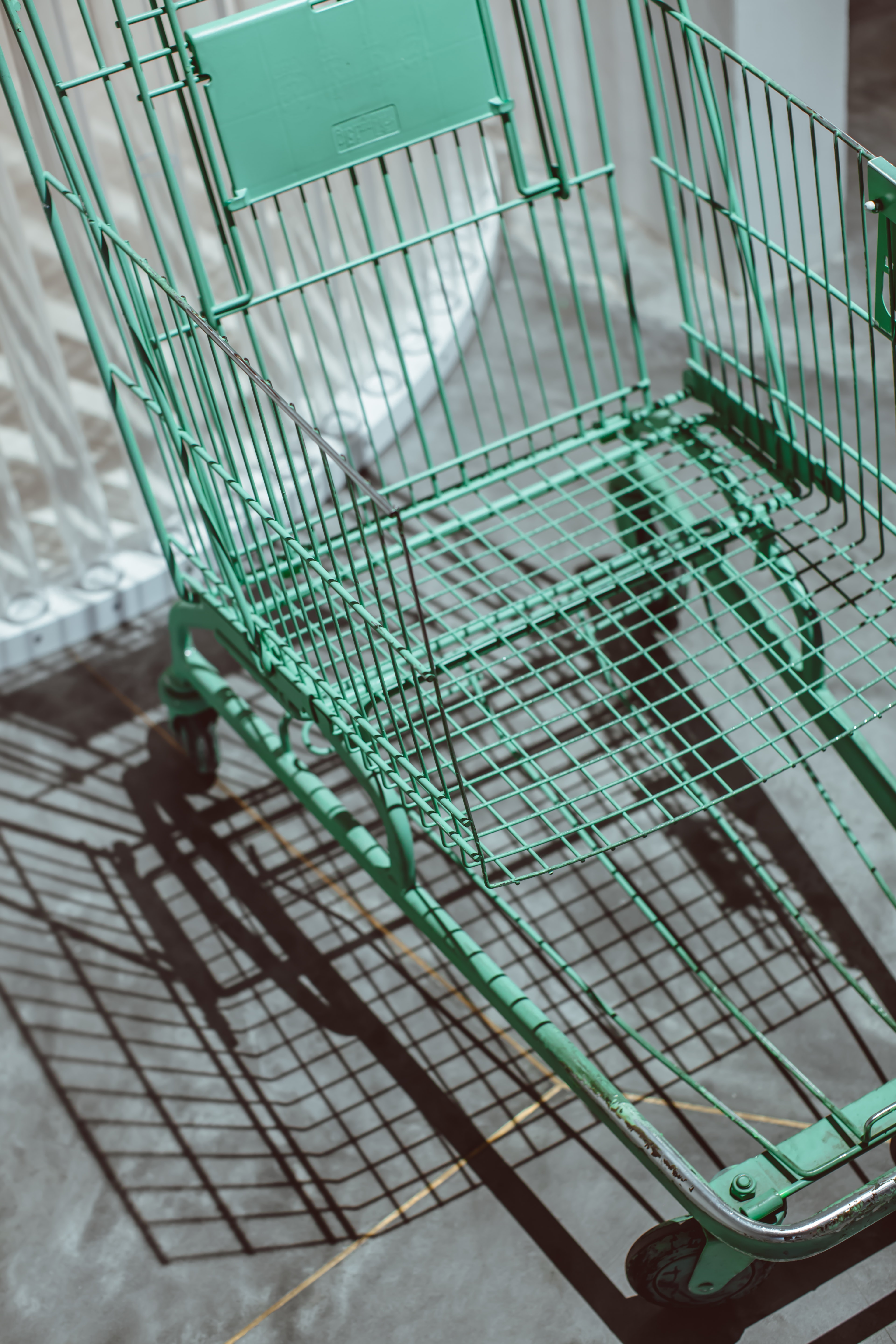
Ready to start experiencing some of those numbers for your brand? We’ll walk you through ways to do that in this guide, covering topics including:
- What is cart abandonment?
- What are abandoned cart emails?
- Platforms you can use to send these emails
- Cart abandonment email strategies
- Examples of abandoned cart templates and emails
- Is it legal to send abandoned cart emails?
We’ll share tips, techniques, abandoned cart templates, and more that will help you improve the effectiveness of your abandoned cart emails.
What is cart abandonment?
The shopper has browsed your site, added one or more items to their cart, and left for some unknown reason, never completing their purchase. For example, we’ve added this item to our cart on Amazon. But instead of clicking the button to checkout and providing our billing and shipping details, we left the website altogether.

The idea of “cart abandonment” is the equivalent of someone walking into a brick-and-mortar store, putting items in their cart, and then leaving before heading to the checkout counter.
It’s pretty straightforward, but that doesn’t make it hurt any less. Luckily, there are things you can do to bring them back, and one of the best methods is via email.
What are abandoned cart emails?
This type of email marketing campaign helps you recapture lost sales by engaging shoppers who abandoned their carts. Basically, the email reminds them to complete their transaction — of course in a nice, fun way.
If you’ve ever added a product to your cart and then ditched it, you’ve seen exactly what we’re talking about. They have subject lines like, “Did you forget something?” or “Your cart misses you.”
Inside the email, you’ll most likely find some engaging copy that encourages them to head back to their cart, along with a photo and description of the product(s), and at least one CTA. Some brands also include information on their shipping, returns, and other selling points at the bottom of the email.
How do these emails work?
Abandoned cart emails are examples of automated campaigns. Here’s how they work:
- You have an online site/platform that tracks user actions on your site.
- Your platform records the products they browsed, what they left in their shopping cart, and their purchases.
- With that information, you can then send automated emails to the shoppers after they abandon their cart.
So once the shopper adds an item to their cart and leaves your site, the platform will register this action (or lack of action, really) as an abandoned cart.
E-commerce sites like Shopify and BigCommerce will automatically track the shoppers’ actions and metrics, making your job that much easier. (And Retention.com has integrations with both of those platforms that allow you to track your revenue from contacts we provide.)
Some of these e-commerce platforms have basic abandoned cart emails, but you can also integrate with your email service provider (ESP) to create and house them there. That will give you more options when it comes to abandoned cart templates. You will simply need to integrate your e-commerce shop with your email marketing tool to create fully customizable, multi-step email campaigns that send multiple emails at certain times based on when they abandoned the cart.
Whether you use the basic abandoned cart templates available in the e-commerce platforms or in your ESP, these will automatically be sent out to potential customers who have abandoned their carts.
Abandoned cart email templates via e-commerce platforms

While you will be more limited when it comes to abandoned cart templates on sites like Shopify, BigCommerce, and WooCommerce, you can use these platforms to send your abandoned cart emails. So, we’ll walk you through how you can create emails on these platforms.
Shopify
You’ll find some basic functionality on Shopify when it comes to creating and managing your abandoned cart emails by going to Settings > Checkout (under Abandoned Checkouts). However, if you want to be able to control the abandoned cart templates and content, you’ll have to install an app like Consistent Cart App, Abandoned Cart Recovery, Jilt, or Privy.
WooCommerce
Since WooCommerce doesn’t have built-in functionality for cart abandonment emails, you could use either the platform’s official extension, Follow-Ups, or a free plugin like Abandoned Cart Lite for WooCommerce.
If you go with the plugin option, you’ll see a new section in your WooCommerce dashboard: Abandoned Carts. That section will be where you can check recovered carts, edit your email content, change the sending settings, and other features.
BigCommerce
Of these three e-commerce platforms, BigCommerce is the only one that gives you full control over your abandoned cart emails. You’re able to control the email design — like what products, text, and images they include — as well as how many emails and when you send them. You’ll find the settings in Marketing > Abandoned Cart Notifications.
Third-party email marketing tools
If you want to go beyond basic abandoned cart templates and settings, it’s time to turn to a third-party ESP. That will give you full control over the look, text, and automation functions.
You can integrate your ESP with your e-commerce platform making it a seamless transition: They leave something in their cart, and the ESP triggers an automated email campaign series that will (hopefully) bring them back to their cart. There are dozens of ESPs to choose from, so find one that best fits your needs.
Cart abandonment email marketing strategies
Now that you have a way to send shoppers an abandoned email, you need to know what tactics that email should include to increase your chances of bringing them back. Here are six ways to boost your recovery rate.
- Build trust and credibility.
- Put your loyalty program to use.
- Focus on one product (sometimes).
- Implement an automation series.
- Create a sense of urgency.
- Address issues that might have kept them from purchasing.
Now, let’s dive into each of these techniques a bit more to see how you can implement them into your cart abandonment email strategy.
1. Build trust and credibility
In this day and age, it’s harder to earn online consumers’ trust because they’ve become accustomed to scams and unprofessional business practices on the Internet. If they’ve never done business with your brand before, you have to work even harder to earn their trust if you expect them to return to their cart and make a purchase. They aren’t going to turn over their credit card information to just anyone.
You can do that by showing them customer reviews and ratings for the product(s) they left in their cart. Make sure your site and emails look professional and include the basics: physical address, reply to email address, logo, and any payment verification information (showing it’s safe for them to use their credit card on your site).
2. Put your loyalty program to use.
Everyone loves a good discount. That’s why you see so many abandoned cart emails that offer shoppers a deal if they come back to their cart. For example, “We have great news! That [PRODUCT] you liked is now 20 percent off!”
But as consumers become accustomed to this tactic, it can lose its effect. So, instead of offering them a deal, try a different approach by giving them rewards in your loyalty program. Again, this is something you can try out to see if it works better than your regular discount message.
You could give them enough rewards points to move up to the first/next tier in your loyalty program — which then gives them a discount. Maybe 100 points is enough for a 10-percent discount. Or, 200 points will give them a $10 discount. They are still getting a deal out of returning to their cart and making a purchase, but you go about it in a different way — and they are able to move up in your program in the process.
3. Focus on one product.
It can be tempting to include both the item they left in their cart and also other recommended products in an attempt to up-sell the shopper or catch their attention. While it’s a good practice to try different approaches with your cart abandonment emails, try only focusing on one product when they add multiple, similar items to their cart.
For example, if a shopper has five different computers in their cart, you can bet they don’t plan on purchasing all five of them — or at minimum, they don’t have equal purchasing intent for all of them. So, your abandoned cart template could include one of the items as the main image, along with the product description.
4. Implement an automation series.
Sending one email letting them know they forgot something in their cart is most likely not going to be enough. Just like you would send someone multiple welcome emails, you need to create an automated series to engage shoppers who have left items behind.
Don’t wait too long before sending the first email in the series. The moment an online shopper leaves their cart, your opportunity to engage this potential customer is narrowing. To make the most of this opportunity, make it a priority to reach out to shoppers within the first hour of cart abandonment. Make this part of a three- or four-email sequence to engage with the shopper.
For example, the first email can go out an hour after they abandon their cart. Then, the next one can follow up one or two days later if they don’t complete their purchase, using a different approach with the email’s content and approach.
If both of those email attempts don’t work, you can try a third (or fourth) campaign that focuses more on the product’s category or general new products. They might not have been that interested in what they added to their cart, so taking a more general approach might be a better way to engage them. The third or fourth email attempt is more of a last-ditch attempt to re-engage with a shopper who has been unresponsive to the first ones in the series.
Sending more than three or four runs the risk of annoying the recipient and getting placed in their spam folder. And we all know that’s the last place you want your messages to go.
5. Create a sense of urgency.
There’s nothing like a reminder that a certain deal is about to expire or that the product in their cart is about to sell out to push them to take action. Use that fear of missing out and urgency as a marketing tactic.
Subject lines are a great place to include this method:
- These products won’t last for long
- Going, going, almost gone!
You can also let them know they only have a certain number of days until the items will be removed from their cart. And who really wants to have to go and add them back, right? Find a way to motivate them to head back, sooner rather than later.
6. Address issues that might have kept them from purchasing.
There are a dozen reasons why they may have left their cart behind. Maybe they changed their mind or found something else they liked better. There’s not much you can do about those two things, but there are other potential roadblocks you can remove and/or address to get them back:
- Include your shipping prices and turnaround time in the email.
- Let them know your returns policy.
- Show them your accepted payment methods (and make sure you have several).
The more potential issues you can eliminate and be proactive about, the better your chances are that they will come back.
Examples of abandoned cart templates and emails
One of the best ways to get ideas for your brand’s abandoned cart emails is to see what other brands are doing and what templates are available in different ESPs. So, we’ve put together a list of templates and real email examples to get your creative juices flowing. You can find others in your ESP’s template library, depending on which platform you use.
We’ll also show you what we like about the actual examples and what they could have done better.
Don’t forget me (template)
Robly has several pre-designed abandoned cart templates, in addition to other template options you can design to be for abandoned cart emails. Here’s the first of three template examples we’ll show you:
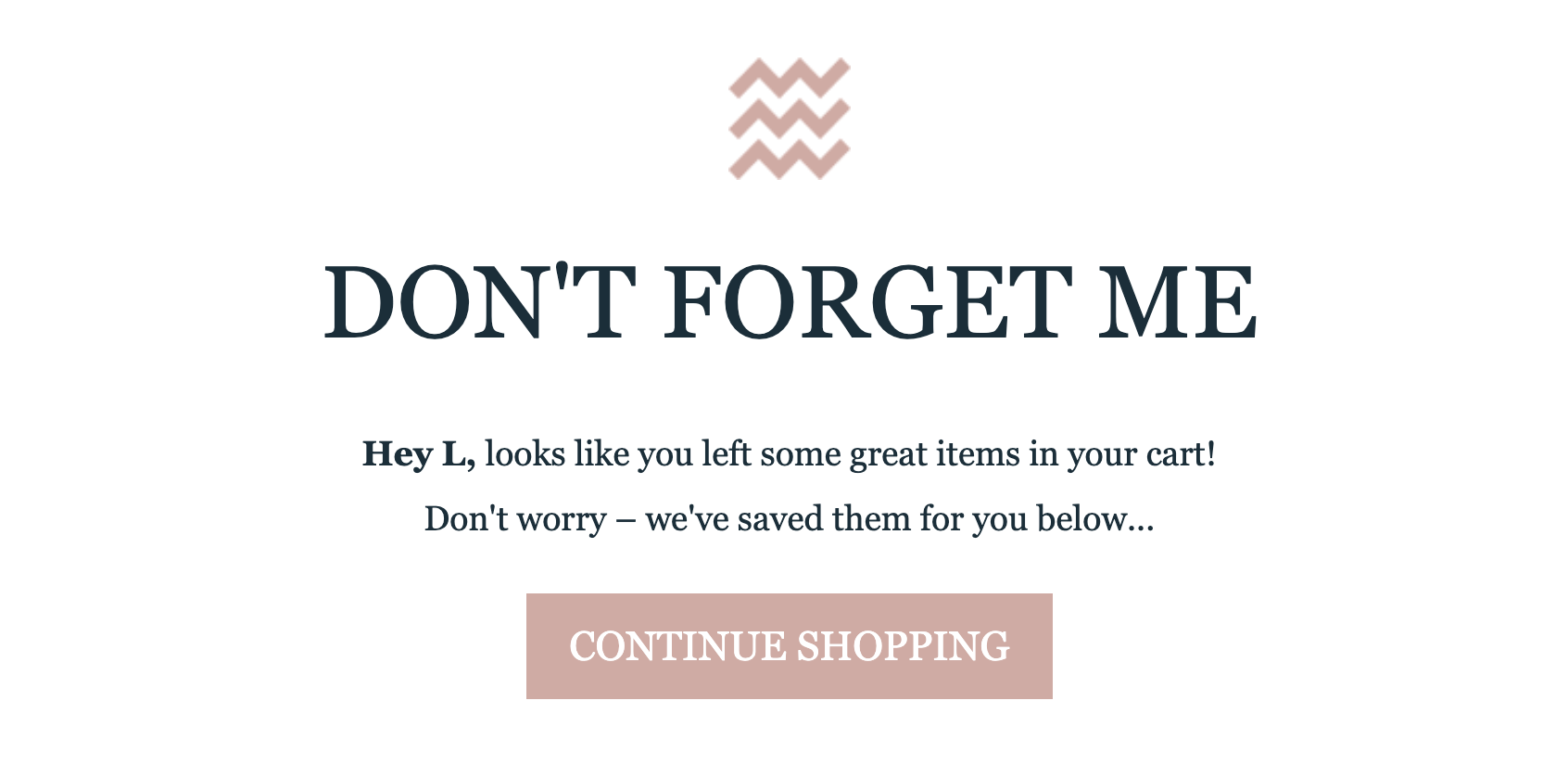
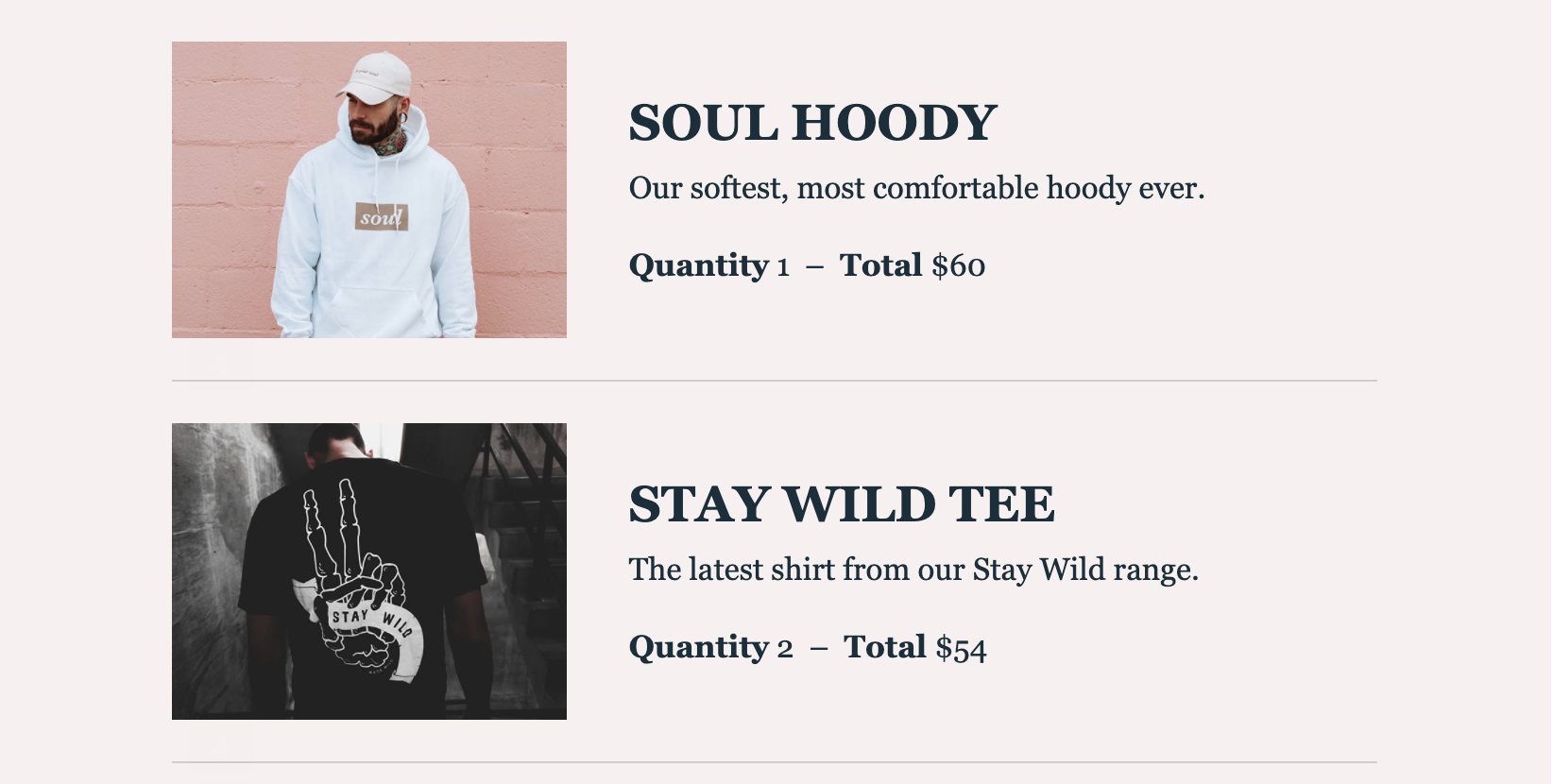


And being a template, you can edit the text, colors, images, links, and everything else to best brand your email.
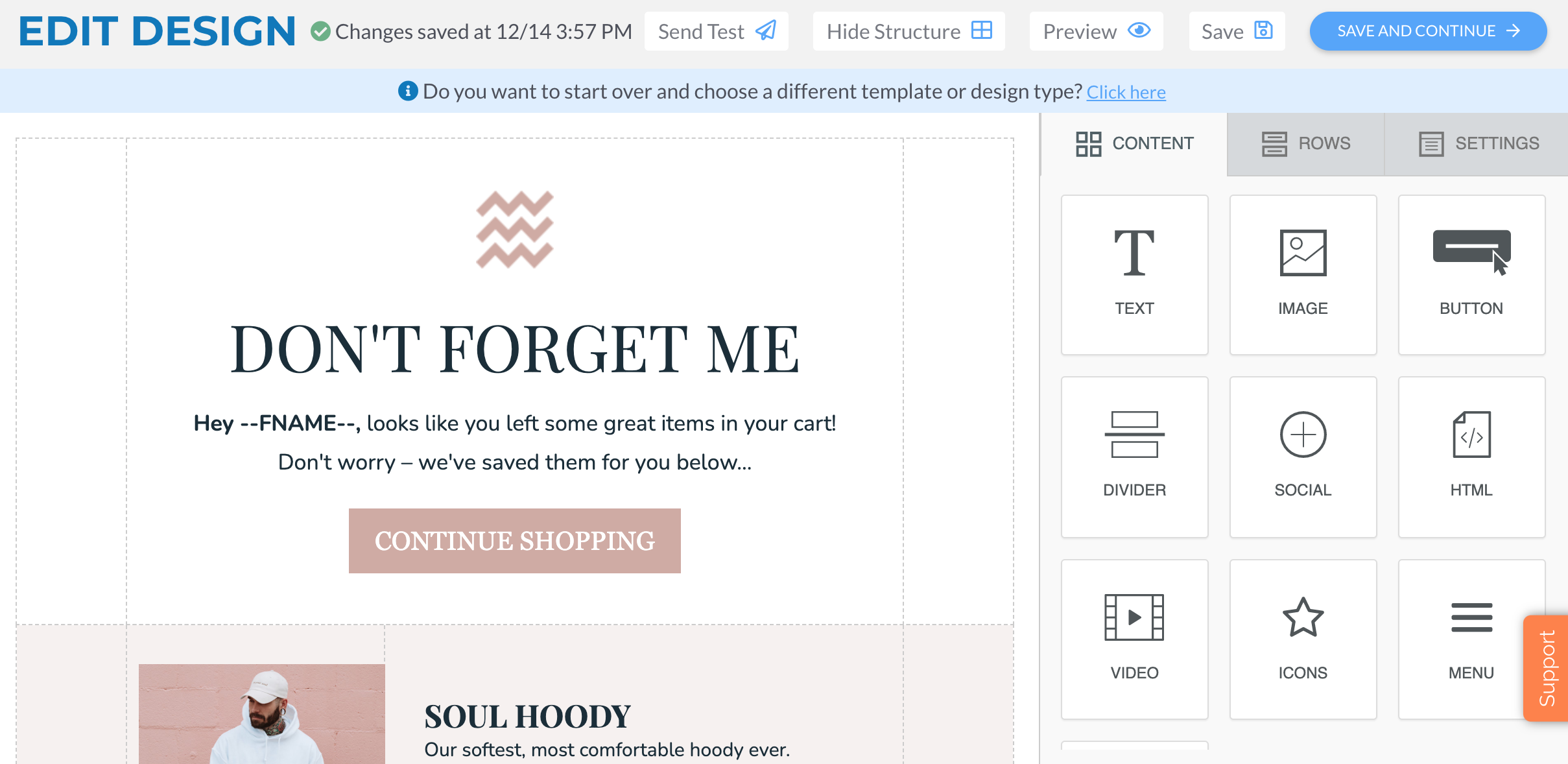
Obviously, you’ll need to change out the photos, product descriptions, branding, etc. with your own materials. But what we like about this template is that it gives you usable text — like “Don’t Forget Me” and “Hey [FNAME], looks like you left some great items in your cart! Don’t worry, we’ve saved them for you below.” The CTAs even fit the content, so you can use what’s already there.
Topo Designs (email)
Subject line: Go ahead, take another look
This email from Topo Designs doesn’t scream “abandoned cart,” but that helps make it different and less forceful. (Though the subject line does allude to it.) When you first look at it, the email seems to be about offering customers a deal on items the brand thinks they will enjoy. But when you scroll down, you see that there’s an item that was left in the cart.
The approach in this abandoned cart template would be especially effective if it was used in the second or third email in the series.
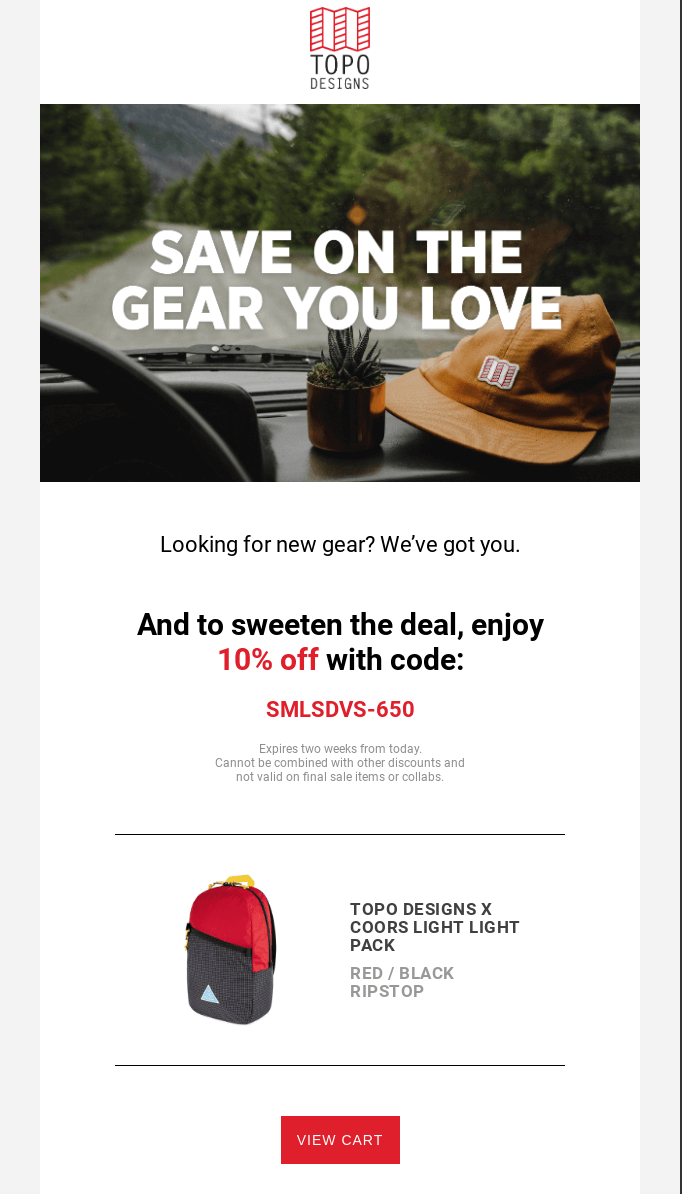
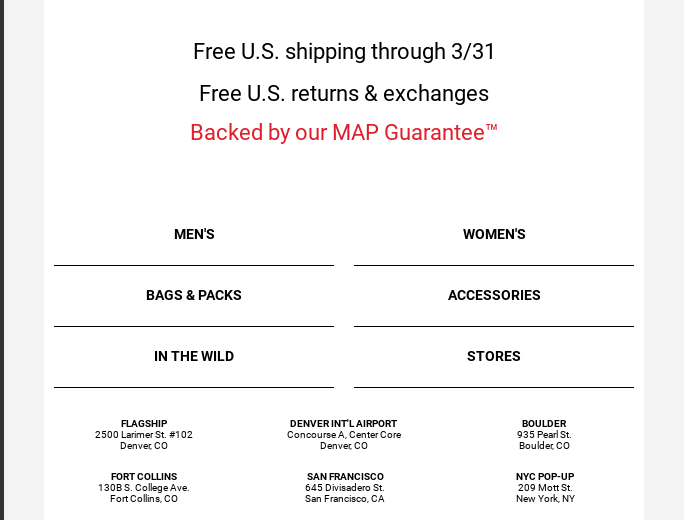
What else we like:
- They show a product photo, description, and clear CTA that just so happens to match the product colors.
- Knowing shipping and returns can be a hurdle for many online shoppers, the brand addresses that by letting the shopper know both of those are free.
- They close out the email by including links to their different departments, in case the shopper would be more interested in one of those. That gives them choices without throwing a dozen different products into the email, which can be overwhelming.
- There’s also a list of their locations with addresses, which adds credibility to the brand.
What could have been better:
- They don’t include the product’s price, and we feel like the shopper will want to know that before heading back to their cart. Since this email offers a discount, the price could even be marked out and show the new price with the 10-percent discount applied.
Still not sure? (template)
Another Robly option, this abandoned cart template shows how the email design can be as targeted and personalized as the text. The header image is a pair of headphones, the same thing they added to their cart.
Sure, you might not be able to have an image like that to match each product, but you could probably create one for your main categories — like a shirt for the clothing department, a computer for electronics, or flowers for the gardening/outdoors category. Anything you can do to personalize the email, the better.
This template also comes with filler text that you could use as is (after changing out the products and images, of course): “We noticed you found these [PRODUCTS] but haven’t checked out yet — here’s some more details to help you decide!”
The template then includes the product photo, price, a product review, and star rating. And of course, there’s a CTA to take them back to their cart.
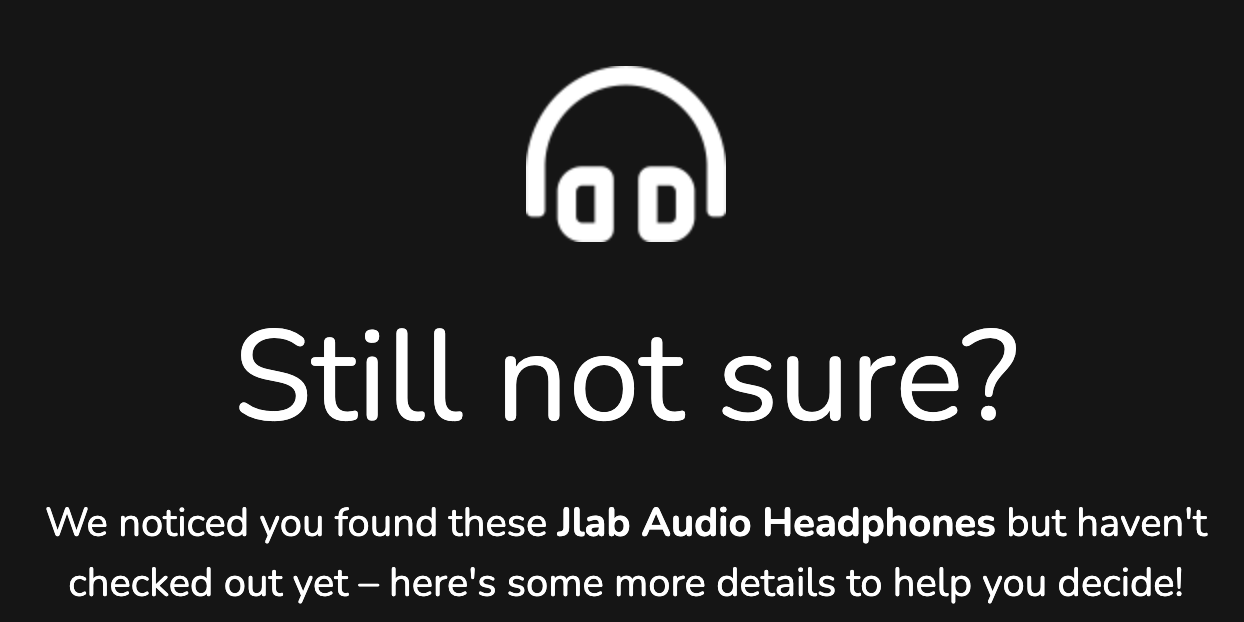
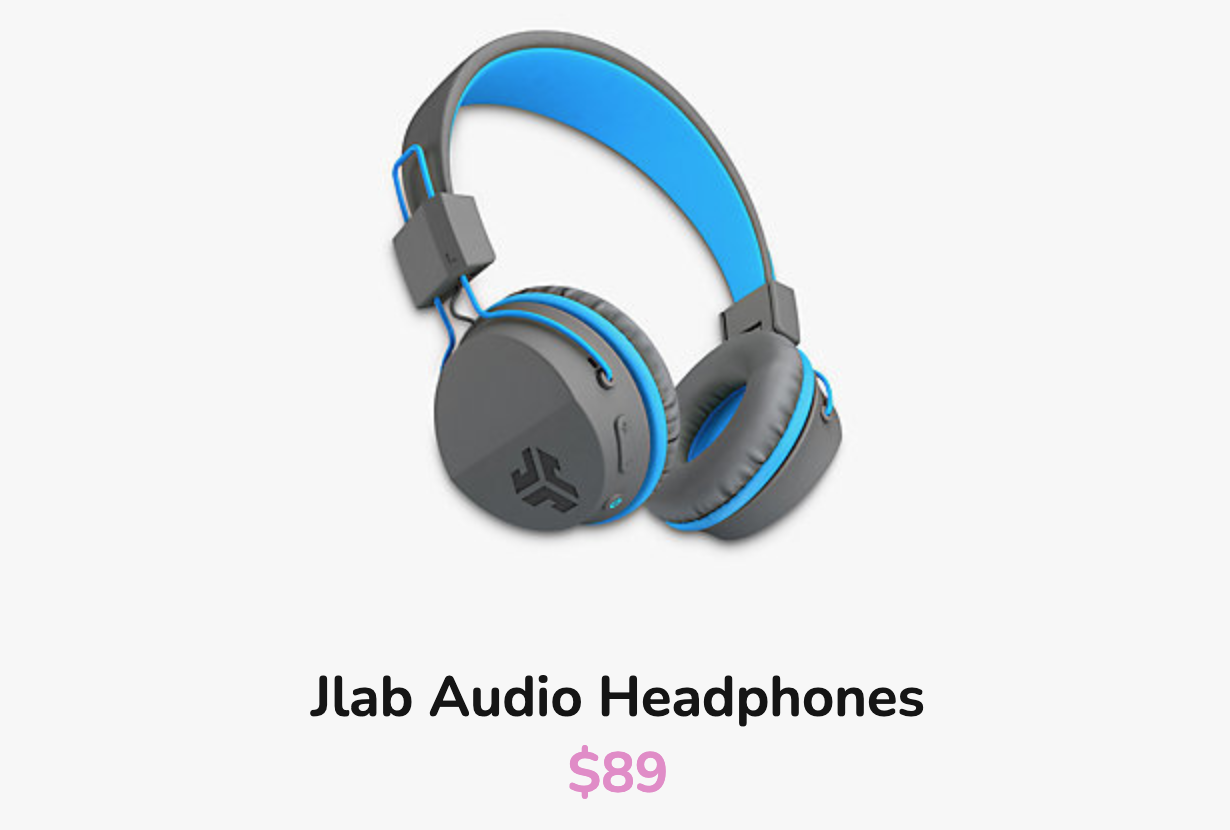
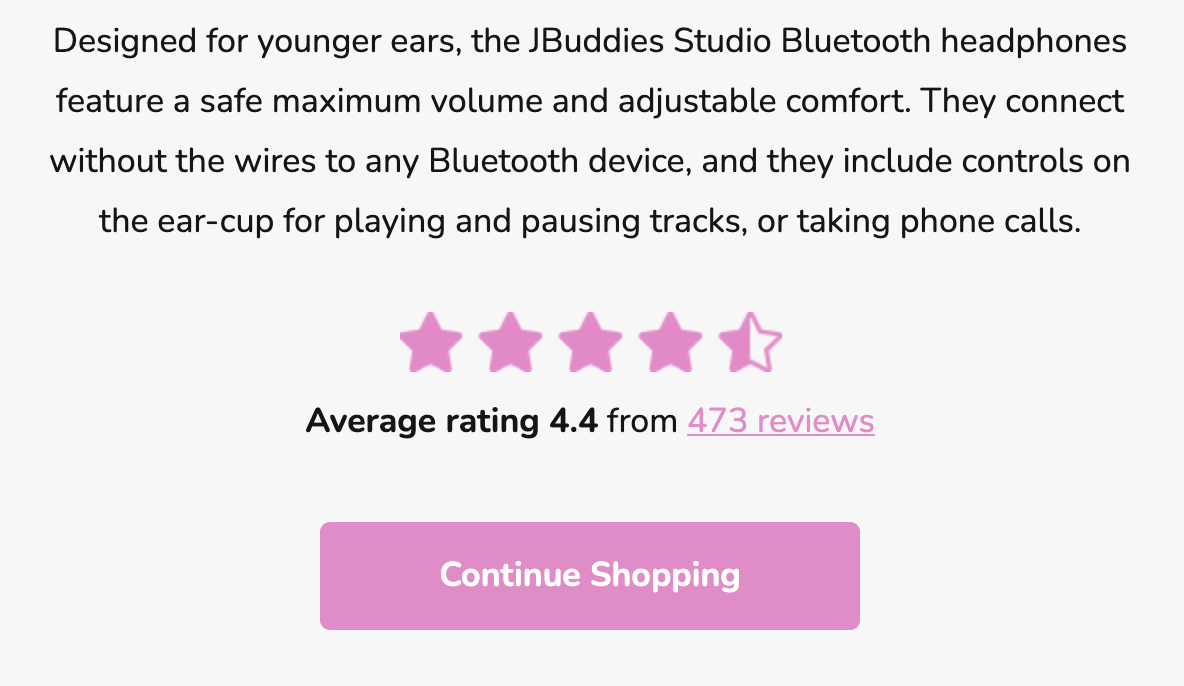
Nomad (email)
Subject line: Nomad Gear is Selling Out Quick
Selling accessories for electronics, Nomad really nails its brand with this abandoned cart email example: “Did your Wi-Fi crash? Fret not — we saved that shiny Nomad product you were just ogling.” The Internet and electronic accessories go hand in hand, and it’s also a lot more fun to read than, “You left something in your cart.”

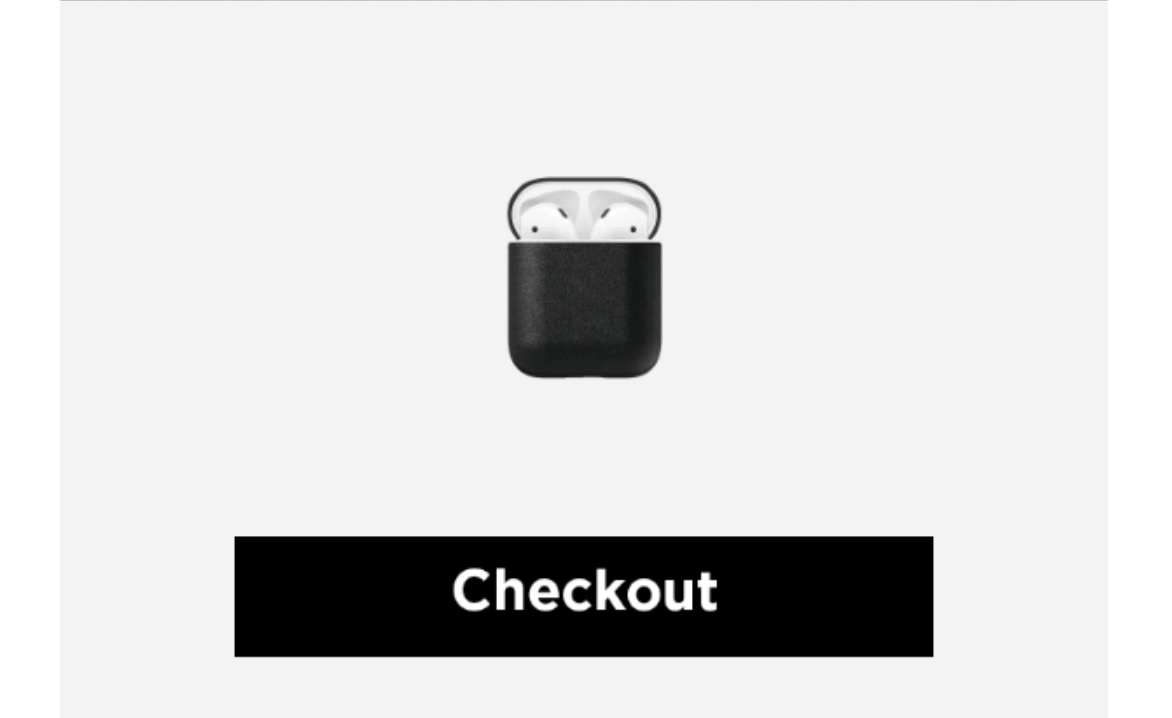

What we like about this email example:
- The color scheme works with the brand and product.
- There are two CTAs, so one will be in view no matter how far they’ve scrolled down in the email message.
- The opening text says they were viewing this product, but it doesn’t specifically say the item was left in their cart. They get the point across without spelling it out, and we like that.
What they could have done better:
- In the opening text, they reference “that shiny Nomad product.” We think this would be more impactful if they included the actual product name — or at least the product category.
- While we like the email having two CTAs, we aren’t in love with the text, “Seal the Deal.” Something stronger might have a better click-through rate, like if they swapped the CTAs, putting “Checkout” at the top and “Seal the Deal” at the bottom. But again, these are our opinions.
You left something (template)
The last of the Robly abandoned cart templates goes straight for a personalized approach with the header having their name front and center: “[FNAME], you left something behind!”
The design then gives you a spot to put the product photo, name, quantity, and price. While it’s not the main focus of the email, there’s also a place to give them a discount code at the bottom.



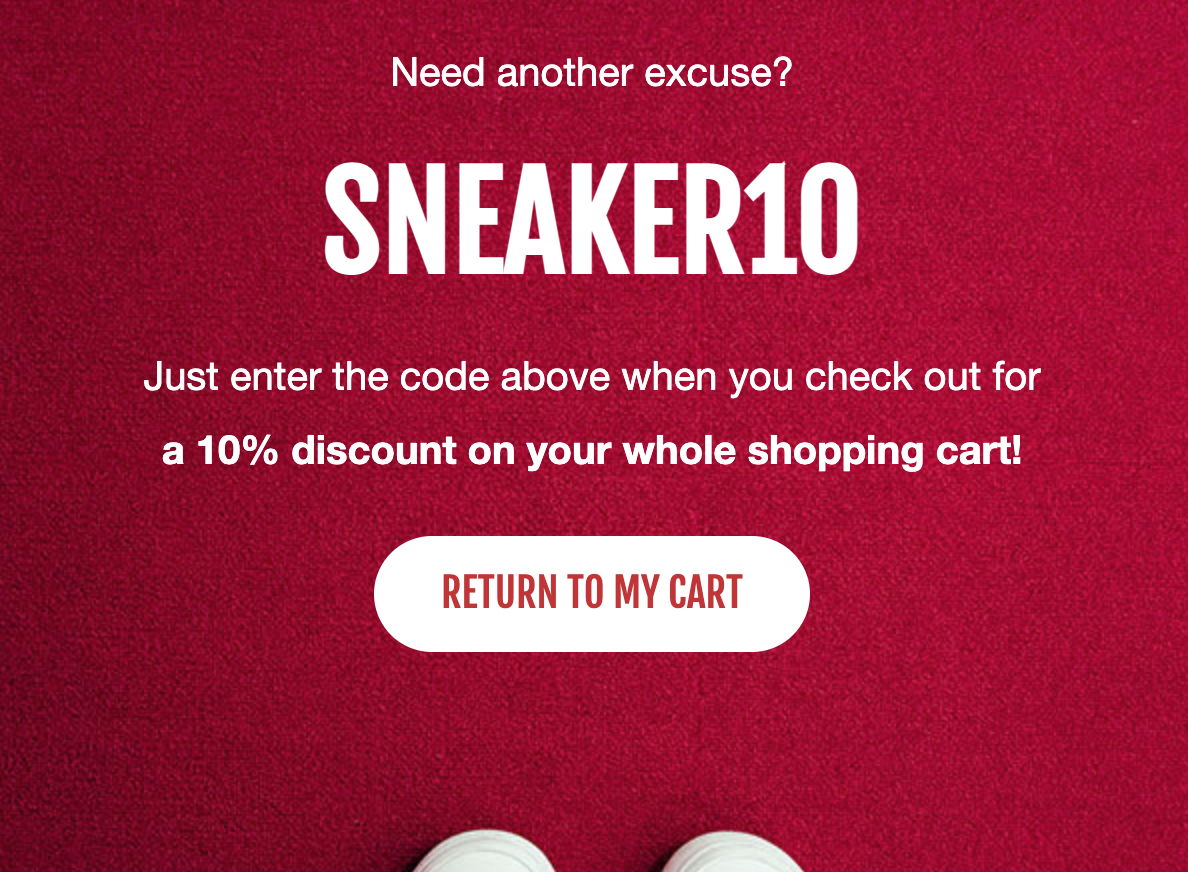
Public Rec
Subject line: You forgot something
Seeing this abandoned cart email from Public Rec makes us happy that a brand is addressing some of the consumer's top concerns right away. Right after their header text, “Take another look,” they go straight into, “Enjoy free shipping and free returns on all orders.” If a shopper failed to purchase the items in their cart because they were concerned about either of those things, now they know those won’t be an issue and can complete their purchase.
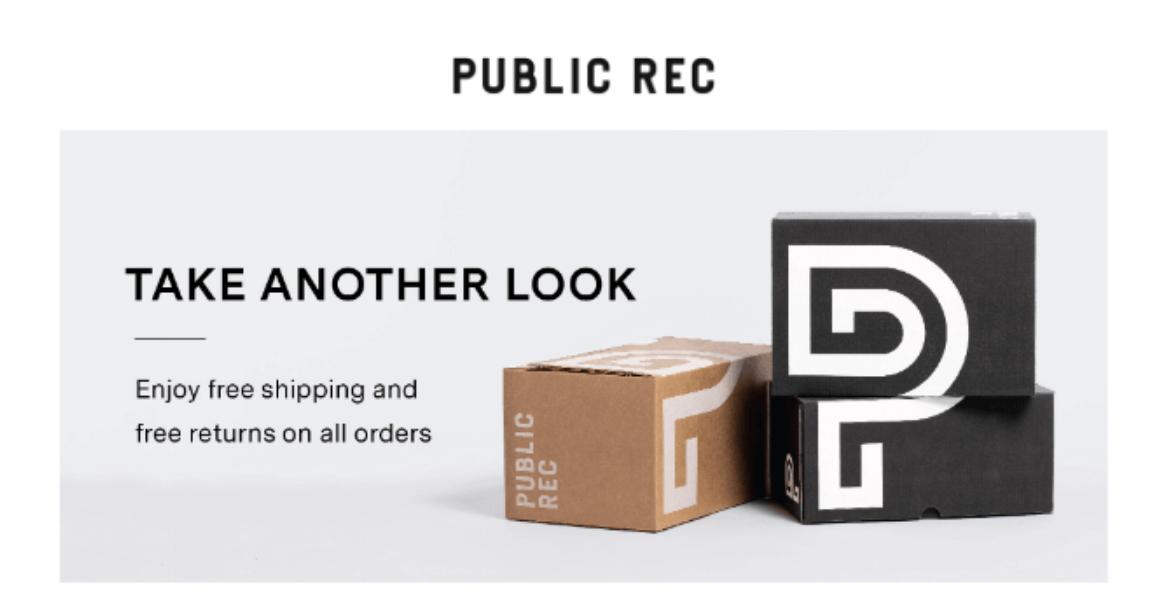
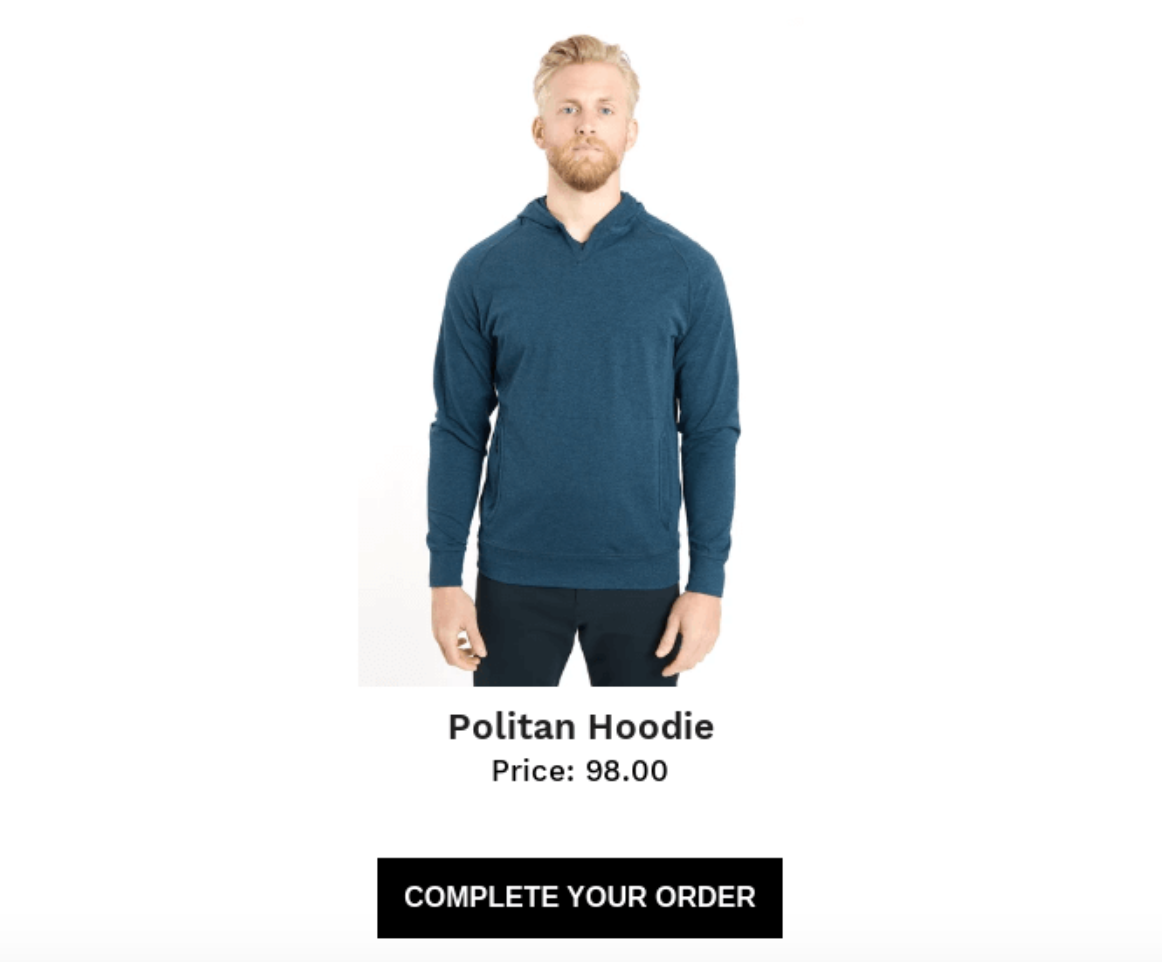
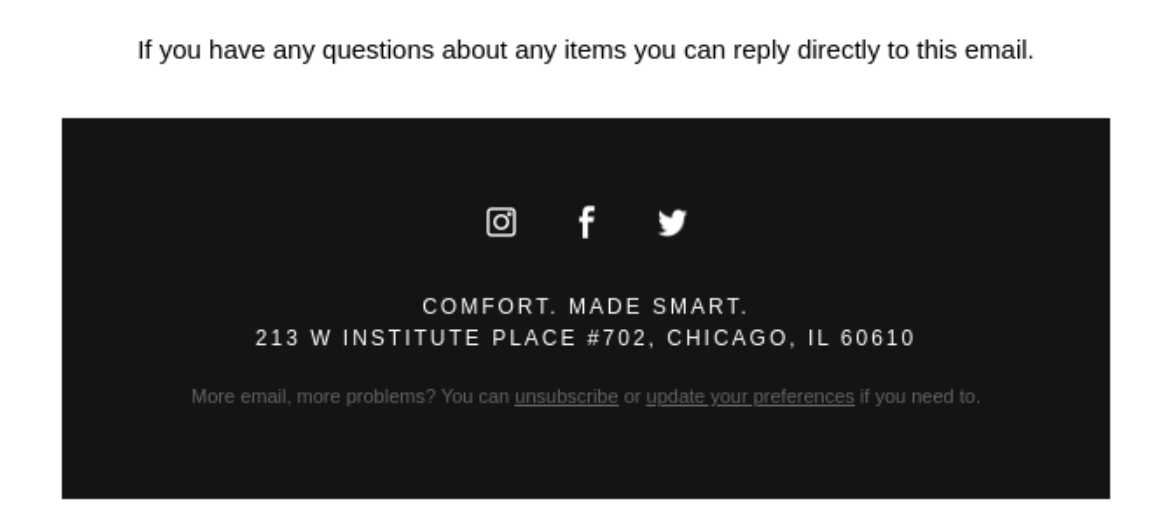
Here are more things we like about this email:
- They include the product photo, description, and price.
- There’s a clear CTA: “Complete your order”
- Shoppers can reply directly to the email if they have questions, which isn’t always the case with email marketing campaigns. The less work they have to do to get in touch with your brand, the better.
What they could have done better:
- We like this email if it’s the first in the abandoned cart series, but if it’s a later email, they could have added recommended/related products to show more options.
Mailchimp (template)
Mailchimp also has abandoned cart email templates, which include a default logo placeholder and Cart content block. That block inserts the abandoned item(s) into the follow-up emails. You can also use one of their other email templates. Just be sure to drag a Cart content block into the email layout.
They offer three pre-designed abandoned cart templates:

Here’s an up-close look at one of them:
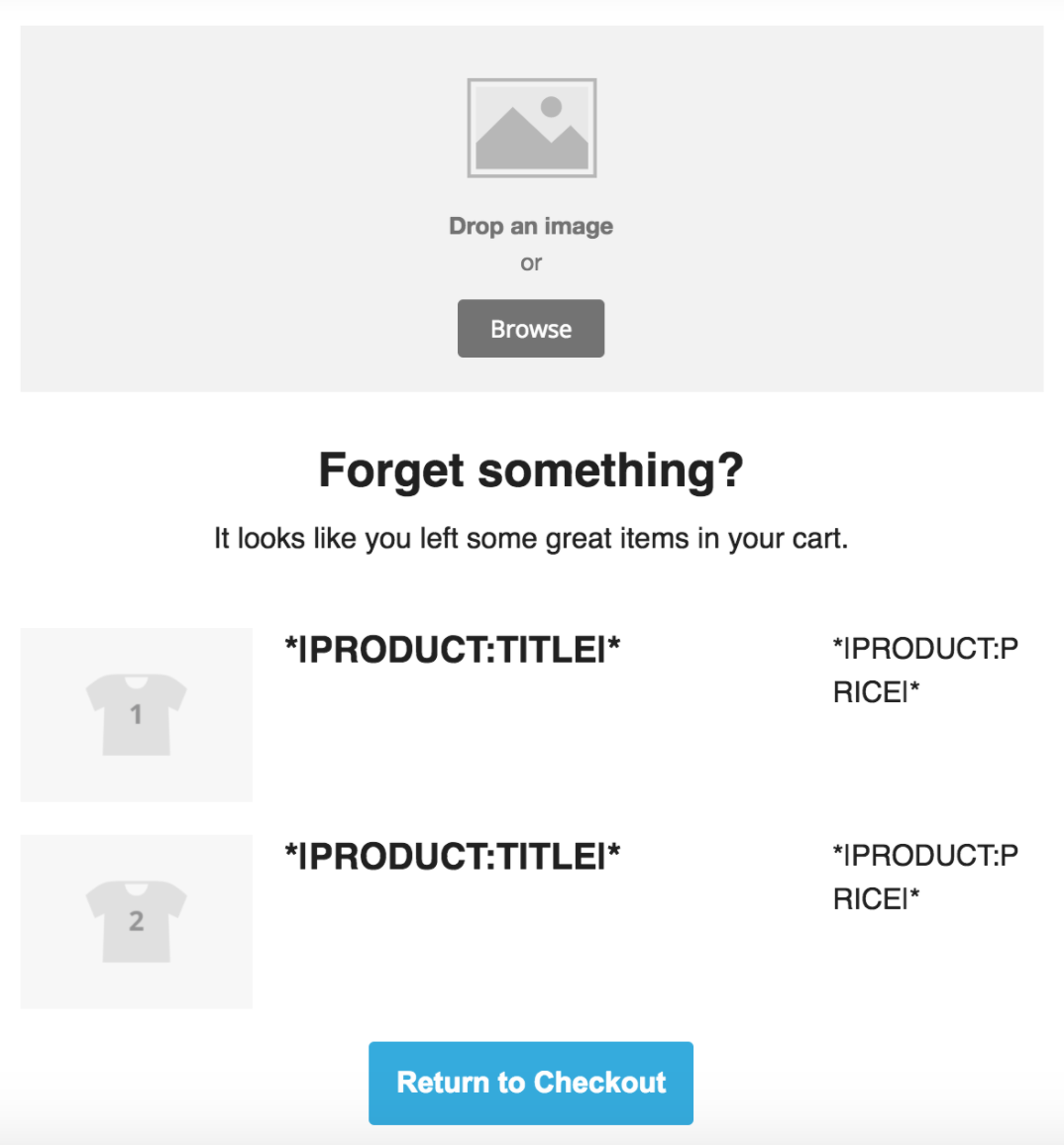
You can also customize the email information:
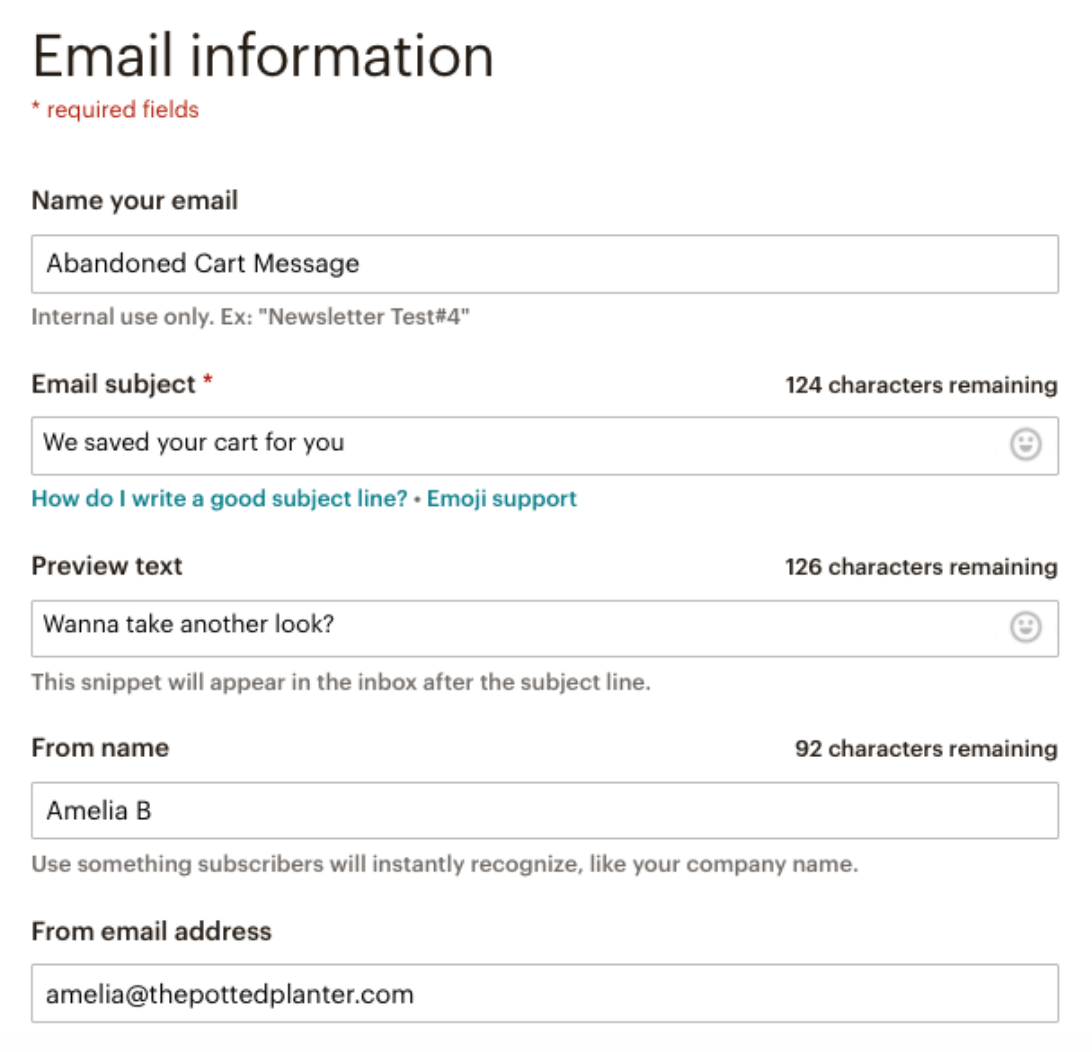
Jack Wills (email)
Subject line: Your basket is having abandonment issues… 🙁
We were hooked on this email from Jack Wills as soon as we saw the subject line. You don’t want to be the reason your shopping cart has emotional issues as they grow up, right?
They carry over that tone into the email with text like, “Don’t worry, we’ve got you,” and “We know life can be hectic.” So, they prove the subject line isn’t just a gimmick to get the shopper into the email: They stay true to that approach throughout the messaging.

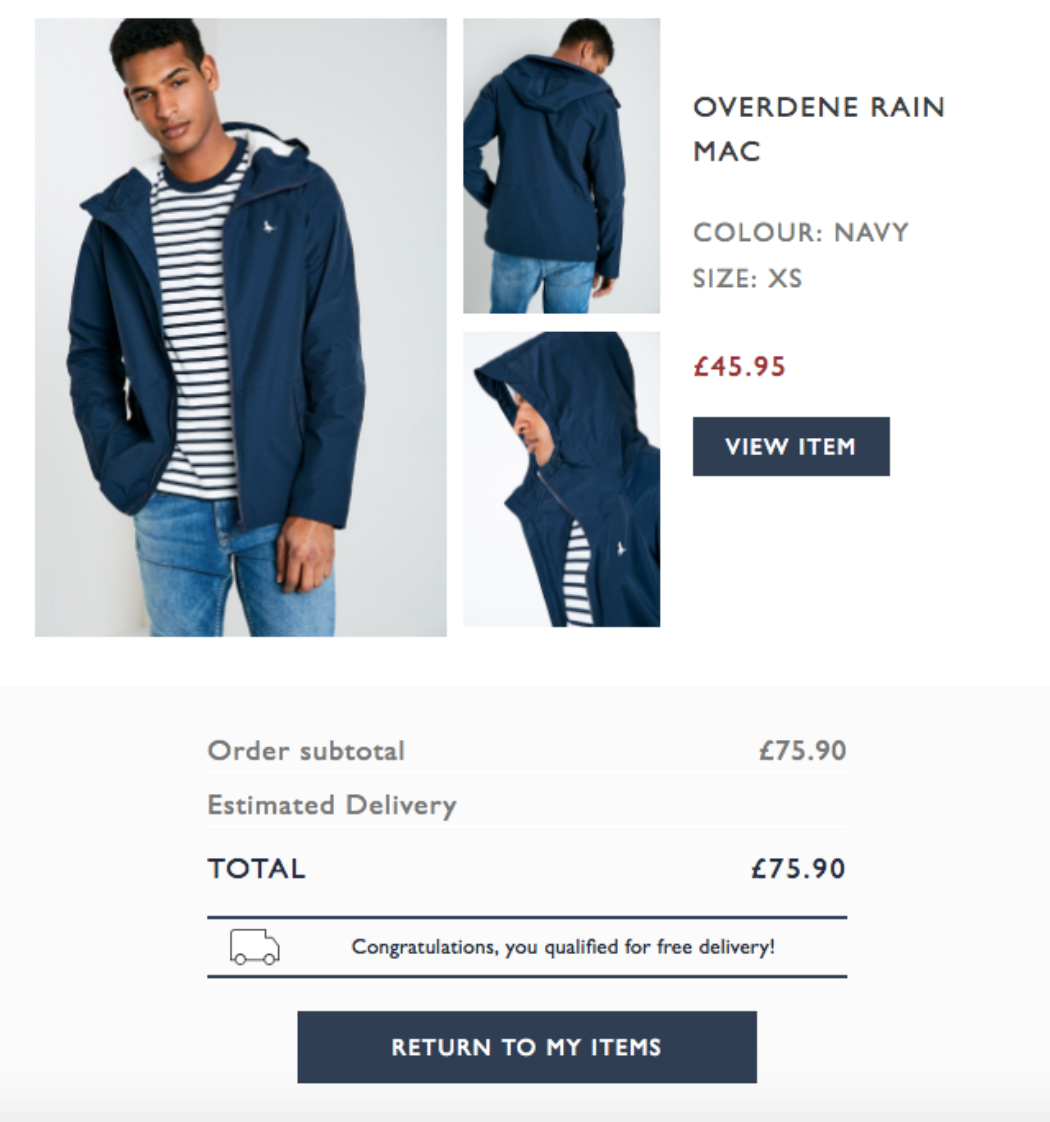
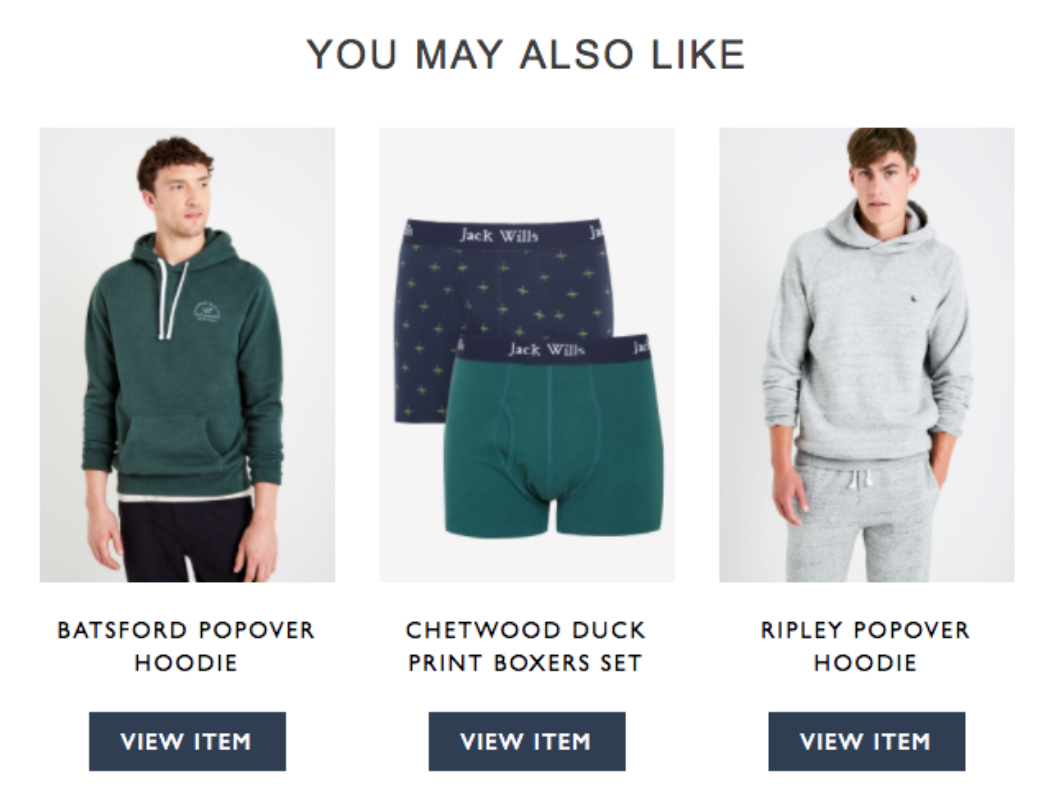
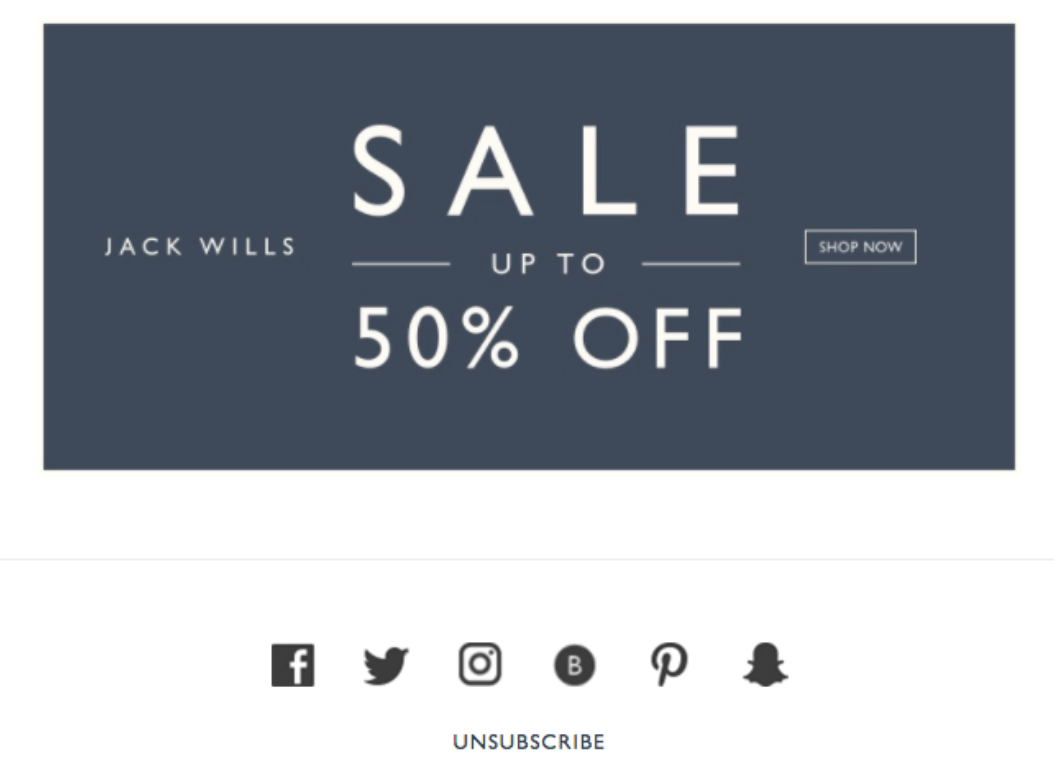
What else we like about this email:
- Though there are four main CTAs in the email body, there are only two different wordings: “Return to my items” and “View item.” So, it doesn’t seem overwhelming.
- They show different views of the product, which isn’t something you see very often in an abandoned cart email.
- In addition to the photos, there’s also the product name, color, size, and price. That pretty much covers it!
- And they take that a step further and include the order subtotal, which is a great addition when there are multiple items in their cart. They even show the estimated delivery cost, or in this case, free delivery (a major plus).
What they could have done better:
- There’s a lot going on in this email, from the products left in the cart to other related products and finally a sale that’s going on. That could become a bit much for the casual shopper, which is why it’s important to use A/B testing with your emails to see which approach works best for your specific audiences.
- While we love the approach they used with the subject line, if they wanted to make it even clearer, they could have used “cart” instead of “basket.”
Are abandoned cart emails compliant?
Abandoned cart emails allow you to provide a targeted, personalized campaign to already engaged online shoppers. Anytime you can do all of those things, you have a winning recipe for ROI.
One question many people ask, though, is if these emails are too good to be true. In other words, are they compliant? To answer that question, we’ll ask you one:
- Did you know you can send emails to people in the United States, even if they haven’t opted-in to your list?
The CAN-SPAM Act for the United States doesn’t require that a subscriber opt-in to your list, just that they can opt-out to any email you send. That’s why Retention.com can collect anonymous traffic off of your website and send you their contact information so that you can target them with emails. Just remember: This approach only works in the United States and isn’t GDPR compliant, which does require you to have explicit consent to email EU consumers.
To take that a step further, Retention.com is also Spamhaus compliant because, in part, we provide verifiable consent (the source record and opt-in date) of every email we pass along to our users. Those source websites’ privacy policies state that by opting in, the subscriber is agreeing that their information will be shared with a partner network for marketing purposes.
Start creating your abandoned cart templates
Now that you have a firm grasp on what does and doesn’t work with abandoned cart emails, it’s time to start creating some of your own and adding them to your automation series. Add your brand’s personal touch to the templates so your subscribers know exactly who it’s from, and test different versions until you find the winning combination. And if you want to start collecting engaged, anonymous traffic you don’t already have off of your site, we can help!
Not all emails are created equal. That’s why different companies have such a range of open and click-through rates. Abandoned cart emails are no different. To ensure yours is going to bring you the best results and get that contact back to their cart, incorporate these best practices into your abandoned cart email strategy. Which of course should be part of your overall retention marketing strategy.
With that, let's get started!

Subject lines
This is the first thing users will see when you send them an abandoned cart email, so don't disappoint. Nearly half of all email recipients say they open an email based on the subject line. So, what should you say to get the open?
The best approach is to keep your subject line simple and to the point. Let them know exactly why they are receiving this message. Consumers receive hundreds of emails a day, so cut to the chase.
Not sure what to include in your subject line? Try some of these components:
- Company name: Let them know who is contacting them.
- Customer name: Email personalization may help you get more opens.
- Friendly tone: If you can’t imagine saying it to a friend in normal conversation, rephrase your subject line.
- Product details: What exactly did they leave in their cart? Remind them.
- Urgency: If they might lose the items in their cart, let them know.
- Simplicity: Because the decision to open your email is made within seconds
Here are more than 10 examples of subject lines that work:
- Cart reserved: Open to see
- Don’t miss out! Your cart is expiring soon
- Empty your cart with 25% off
- Take 10 percent off before your cart is gone
- Still deciding? Your [PRODUCT] is waiting!
- Did you forget about me?
- [CUSTOMER NAME], did you forget something?
- Oops, you forgot something
- Where’d you go?!
- A gentle reminder…
- Your cart is expiring. You may qualify for free shipping
- There’s something in your cart
- Thinking about [PRODUCT]?
- Did you forget about me, [NAME]?

- Your cart MADE us send this reminder

- Is your wi-fi ok?
Adding personalized information, like the shopper’s name or the item they left in their cart, will better catch their attention and clearly state this email is just for them.
Create a sense of urgency
Alerting potential customers they might lose the items they’ve placed in their carts is a great way to tap into the scarcity effect as a marketing tactic, as long as you’re being honest.
You can do that by incorporating one of these tactics into your email:
- Reserve their cart for a limited amount of time (with a countdown)
- If their item is limited edition, let the know it won’t be restocked
- Set an alert showing how many other people have the item in their cart (similar to how travel sites tell you how many people have viewed that property in the past 24 hours)
- Let people know if their item is likely to sell out due to popularity
This email from Google is a great example of creating urgency:

From the headline, “Going, going, (almost) gone,” to the content saying their popular items sell out fast, this cart abandonment email is all about creating a sense of urgency. The email is short and to the point, which is a definite must for this type of message.
They also include the company’s contact information, which consumers could use if they had any questions or issues. That’s great to include in case the original reason they didn’t make the purchase was because of an issue or question.
Content
If your subject line does the trick, your potential customer will have made their way into the email body. Yay! Now that they are there, you’ll want to make sure your content makes these three points:
- They liked something enough to put it in their basket
- It was left in their online shopping cart
- They should return and complete their purchase
Everything you should include in your email is a means to that end. Basic elements to include in the email that will help you reach that goal include:
- Shopper’s name (if you know it)
- Sentence reminding them they haven’t completed their purchase yet
- Details about what they left in their cart
Your brand’s personality needs to shine through with every piece of marketing content, including your cart abandonment emails. That allows you to recover sales by being distinctive in a cluttered inbox.
This is a great example from Columbia:

Showcase product
The reason for your abandoned cart email is to get that shopper back to their cart to complete the purchase. One major part of doing that is showing them exactly what they’ve left behind.
- Don’t hide that information: Reveal that product like it’s on the Price is Right.

Using a large product image can turn a good abandoned cart email into a great one. Your abandoned cart email should be designed to reignite your customer’s excitement. There’s a reason the shopper added the item to the cart in the first place, so remind them of that.
People might not remember what products had them clicking the “add to cart” button in the first place. If they open your email and are still confused, they’re probably going to delete the email, and you’ve lost a potential sale. So, make the product image the main event.
Similar offerings
Maybe they didn’t complete the purchase because the product wasn’t the best one for them. To combat that issue, you can (sometimes) include an alternative product to the one in their cart. We say “sometimes” here because you might not want to do that with every abandonment email, since that could take away from the main one they really do want. They did add it to their cart, after all.
You could send them an email with the product in their cart as the main image. Then, include two or three similar product photos (with links) below that, in case one of those better catches their eye.
This approach is similar to what you see on Amazon’s “Customers who viewed this item also viewed” section:

Or, you can try showing them related items to include in their cart that won’t distract from the primary product, such as:
- Accessories for the main item
- Different patterns or colors for the same item
You want to give them items of value, without taking away from the item they obviously like.
Address issues

There are several reasons why people might leave their cart, as we covered above. So, why not address a few of those possible problems or questions in your email? That will help you cover several bases and get them back to their cart.
Using your customer research and website usability testing (or some of the top reasons we mentioned above), create an email that shows you understand their concerns and will address those issues directly with this abandoned cart email. That’s exactly what Whisky Loot did in this fun email:
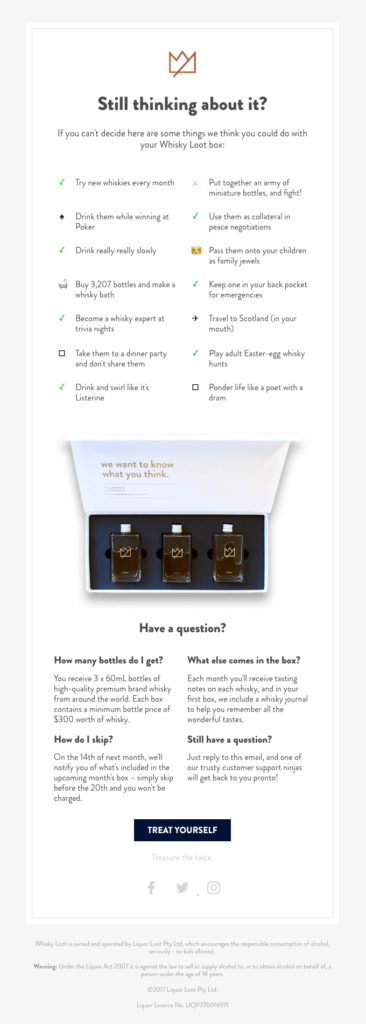
The brand stays true to its voice by sharing a lighthearted checklist of things customers can do with their product. The email also answers questions that might be holding up people from making the purchase.
This is a great tactic you can easily incorporate into your message. You can use some of the top questions you hear from people on your:
- Site
- Social media pages
- Surveys/research
Besides some of the top concerns — like shipping costs or returns — it can also help to include if you offer financing information for more expensive items. For example, if you provide 0% interest, include that in your abandoned cart email.
Big-ticket items require a significant commitment from an online shopper. These purchases are a big decision. It's your job to convince customers to trust in your brand, and the safety of financing without interest gives customers one less reason to bail out of the purchase. A large, “0% interest” banner is perfect for your price-conscious customers.
(Bonus: For expensive items, incentives like an offer or free gift are great ways of enticing the customer to complete their purchase — especially if that gift is an accessory matching the abandoned item.)
Also, make sure to give them contact information for your company if they have other questions, in case you didn’t cover theirs.
Call to action
Let them know exactly what you want them to do once they open your email (i.e. purchase the items in their cart). Do that by making the CTA prominent in your design. The components of a good CTA for an abandonment email are:
- Be direct (but nice). Your button could say “Return to your cart,” instead of using words like “buy” or “pay”
- Only include one CTA to make sure it’s clear what you want them to do (though there are a few exceptions to that rule, which we will cover later)
- Color/design of the CTA stands out from the rest of the email body
Here’s an example from Bearsville Soap Company that uses the “Return to your cart” CTA:

The CTA emphasizes how easily they can finish the checkout process they started, without being pushy. We also like the bear emoji in the subject line, which helps the message stand out and reinforce branding.
Frequency
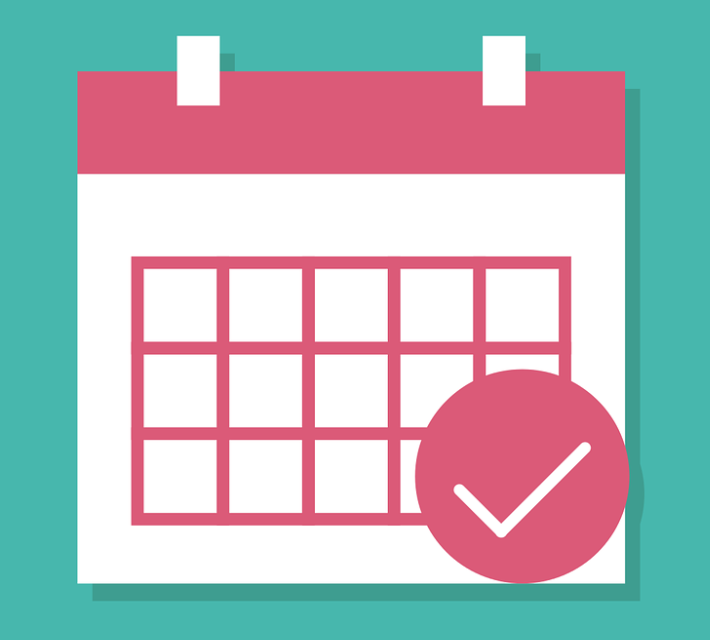
You can set up a series that goes out all on its own – and wins back revenue that would otherwise have disappeared. Like we mentioned above, you’ll want to send the first email fairly soon after they leave their cart. You should also continue to follow up with them using a series of emails if they don’t complete their purchase after the initial email.
This example sequence is one that many brands, including Target, use following a cart abandonment. It starts on Day 3:
-
- 3: Send first email with a subject line like “Come back and see what’s new,” with some sort of personalization at the front — “Kids’ Clothing: Come back & see what’s new”
- 4: Send a significant discount across the entire category the user was browsing. The offer should be front and center, placed directly in the subject line and as the first call out in the body of the email — “Need kid’s clothing? Take up to 25% off today”
- 4: A few hours after the first email is sent that day, send out another like “The price dropped for something in your cart”
- 5: Resend the notification regarding the price drop with an updated subject line — “Price drop alert”
- 6: If the previous attempts have failed, you can switch back to more category-specific offers. So, if they had originally added children’s clothing to their cart, you could try something like, “All of the outfits they’ll need for school.”
- 7: Pick out personalized products based on what’s in their cart. For example, if they added a boy’s sweater with a dinosaur on it, send them other clothing options that have dinosaurs on them with a subject line like, “Outfits he’ll roar about!”
As you can see, an abandoned cart email strategy includes way more than just one message. You want to use the information you have on them, like what they’re interested in, to provide the most targeted emails possible.
Here’s an example of an email series Wayfair sent after we added curtains to our cart:

They sent a total of five abandoned cart emails spanning nearly two months. These are the subject lines they used:
- CURTAINS you’ll love!!
- The curtain for you!
- CURTAINS & DRAPES: Living Room **SALE**
- ▓▓▓▓ CURTAINS & DRAPES ▓▓▓▓
- CURTAINS you’ll love!! [This one was sent at the beginning and end of their email series]
This is the email they ended the campaign with, which was similar to the first one we got:
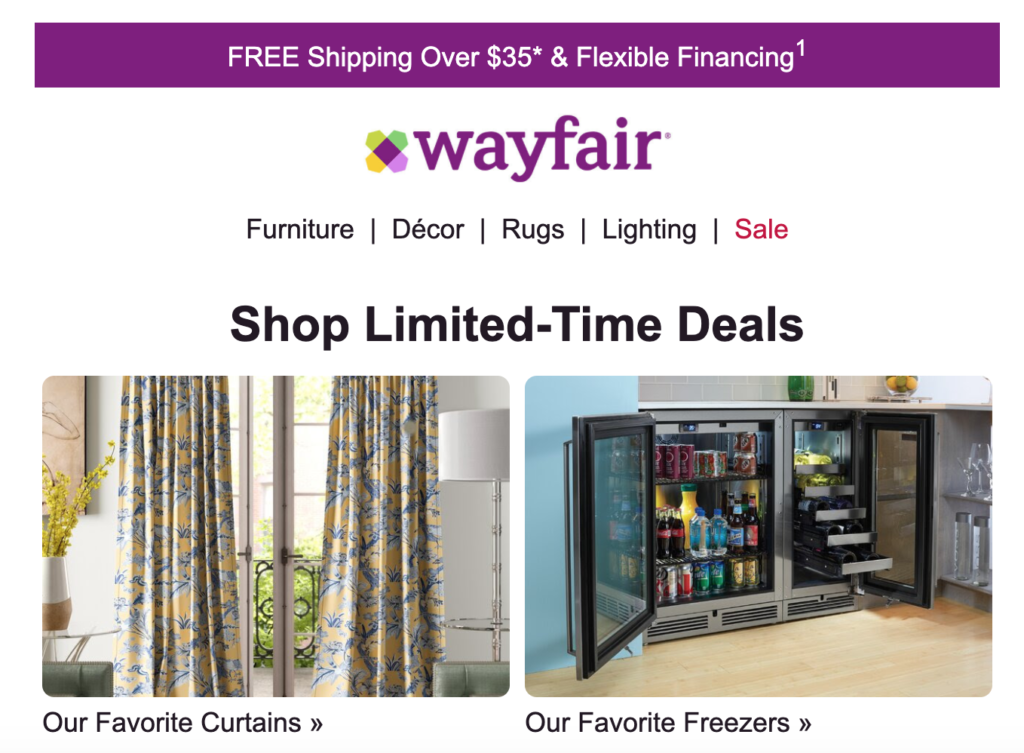
They not only showcased the product we had originally added to our cart (curtains), but they also included other popular home items.
Show proof

What do you do before making a purchase? We’d venture to say the vast majority of you look at reviews to see what others have to say about a product first. We all want to see that social proof, so use that to your brand’s advantage by including reviews in your abandoned cart emails.
Go through your reviews, and pull out the best ones for the product or service they’ve looked at. If you don’t have any, reach out to your top customers for one. The subject line could be:
- See what others are saying about [PRODUCT]
- Why this [PRODUCT] earned a 5-star review
- Our most talked about products
Unsubscribe
Like with any of your email marketing campaigns, you’ll need to include an Unsubscribe button or link somewhere in the body of your email. Make unsubscribing as easy as possible, so don’t try to hide it or make it super small.
It doesn’t help you or the shopper if they aren’t interested in receiving your emails, and they can always resubscribe later if they choose. If you try to force people into receiving your emails and buying your stuff, you’re destined for complaints, failures, and a struggle to maintain profitability. Let people opt-out before they start to distrust or dislike your brand.
An effective unsubscribe button usually is at the bottom of an email. That’s where readers will look. Try to use a different color, font, or even use italics to make an unsubscribe CTA stand out. You don't need to go overboard with font size. You can keep a smaller size font if you want, but make sure it’s readable.
In summary

Abandoned cart emails are about more than getting the shopper to complete their purchase. The email should also be helpful and answer questions so they can complete the purchase when they're ready.
Take this opportunity to create a lasting relationship with your customers and aim to convert your shopper into a loyal brand fan. You want them to become promoters of your business, not just a one-time customer.
While short-term profits from discounting and sales promotion are great, what happens when your promos run out and it’s just a regular day? If you have an effective email cart abandonment strategy in place, you won't have to worry about not having a sale to lure them in.
- You'll know your customers agree with the price you sell your products for.
- They'll be willing to purchase for the full price.
You’ve seen the stats, best practices, and tons of examples. You have power and knowledge. We’ve given you everything you need to make your abandoned cart emails the best they can be.
Remember...
Even if you follow these steps to a T, you might not be able to capture every single abandoned cart user. Not every shopper is serious about making a purchase, or maybe they are just comparing products.
Even if you don’t close every sale, you’re creating a solid foundation that will help the visitor learn about your brand, that you care about current/prospective customers, and make it easier for them to find your products if and when they decide to make a purchase.
It takes several interactions with a consumer before they ever convert, and abandoned cart emails are a great way to start engaging with them. So, it’s time to get started, and add them to your marketing strategy!
Getting customers to visit your site and place items in their cart is only half the battle. According to Baymard Institute, cart abandonment rates average around 70% on most e-commerce sites. Re-engaging even a fraction of these customers can drastically increase a business's revenue. Luckily, there are numerous straightforward ways shopping sites can reclaim abandoned cart revenue.
How to reclaim abandoned cart revenue
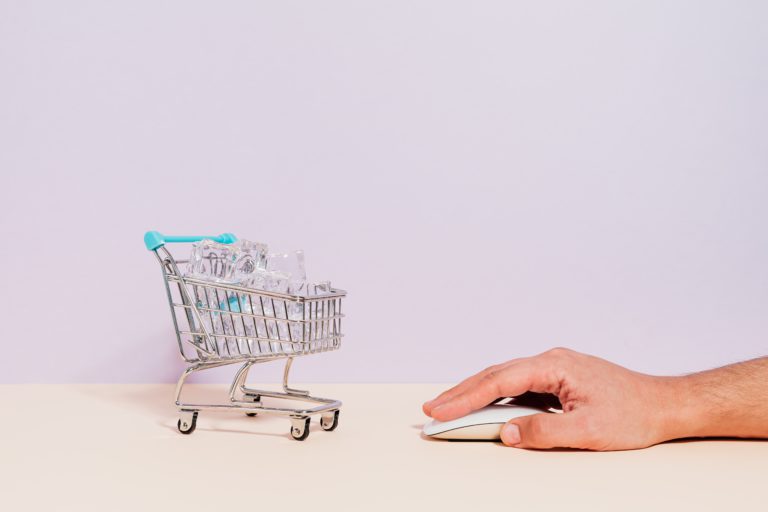
Personalized abandoned cart emails
Abandoned cart emails are nothing new; you’ve likely received these emails from Amazon and other e-commerce sites you frequent. However, many abandoned cart emails feel more like advertisements than personalized messages.
Personalized abandoned cart emails drastically improve revenue potential, especially those acknowledging your customers’ shopping habits. For example, triggered emails that recognize first-time shoppers may read differently than those sent to long-time customers. Emails sent to new buyers can offer introductory gifts or how-to guides, whereas those sent to long-time customers may provide benefits for their loyalty.
Engage anonymous cart abandoners
Reclaiming abandoned cart revenue gets trickier when you realize how many of your customers are unidentified. In some cases, these customers aren’t on your email list. In other cases, they’re on your email list but aren’t logged in.
Sending emails to unidentified customers can be challenging. Luckily, Retention.com’s CartID+ tool can use cookies to reach out to otherwise anonymous customers. CartID+ can even send abandoned cart emails to customers who haven’t opted into your newsletter.
SMS notifications
Emails aren’t the only way to get a customer’s attention; text messages can be a more engaging medium for retention marketing. Some sign up for website mailing lists using emails they’ve created to collect spam mail. Although abandoned cart emails aren’t spam, some of your contact attempts won’t be seen if you only use emails to engage cart abandoners.
SMS notifications can’t be flagged as spam and are more likely to be seen than emails. Additionally, some studies suggest mobile customers are more likely to abandon their carts than desktop users. Text messages are an ideal way to communicate with your mobile site users.
Learn more about your customers
Personalizing communication is an exercise in futility if you know nothing about your customers. Apps like Retention.com’s Enrich tool can provide valuable information about the people visiting your site. Learning more about your shoppers’ demographics and interests can enhance your email-campaigning efforts.
Knowing whether a customer has a kid, a pet, or a specific hobby will improve your site’s product recommendations. The Enrich tool, combined with your abandoned cart information, is vital to building a customer profile to enhance your triggered emails.
Offer discounts and alert customers when sales are live
Sometimes, people abandon their carts because they decide an item’s price is too high. Offering a discount can be an excellent way to reclaim abandoned cart revenue. As a matter of fact, some customers abandon their cart specifically because they think they’ll receive a discount.
Popular sites like LifeHacker teach customers to use cart abandonment as a method for buying products at a lower price. It isn’t uncommon for a customer to place a product in multiple carts across multiple sites and buy it from the one that sends them a coupon. Still, you don’t have to cut into your profits to engage customers.
Sites like Amazon observe products that customers leave in their carts and send them emails when they go on sale. This method lets you re-engage cart abandoners while making the most of your planned discount events.
Create a guest checkout page
Many customers abandon carts because they don’t want to waste time creating an account. Customer accounts are ideal for collecting emails, phone numbers, and addresses for future engagement campaigns. Still, customers who can’t buy your products without creating an account may choose to shop elsewhere. Guest checkout pages are a simple way to make it easier for customers to shop on your site.
Display shipping options on the product page
Some customers abandon their carts because the shipping costs catch them off guard. Some sales methodologies suggest obscuring a product’s price by hiding shipping costs until the customer is ready to check out. However, the modern consumer has grown tired of dishonest sales practices.
Although you may not be able to reduce shipping costs, being upfront about them can reduce your abandoned cart rates.
Stick with what works
There’s no such thing as a one-size-fits-all approach in retention marketing. You shouldn’t spend time on campaigns that you run blindly. Monitoring your engagement campaigns and investing more time and effort into the methods yielding the best results is essential.
If you’re considering an application or service to help you with customer retention, you should ensure it offers in-depth reporting. Retention.com tracks revenue and ROI weekly and monthly, making it easy to access your needed data. Additionally, Retention.com has valuable insights into the domains, landing pages, and times of day that generate the most emails.
